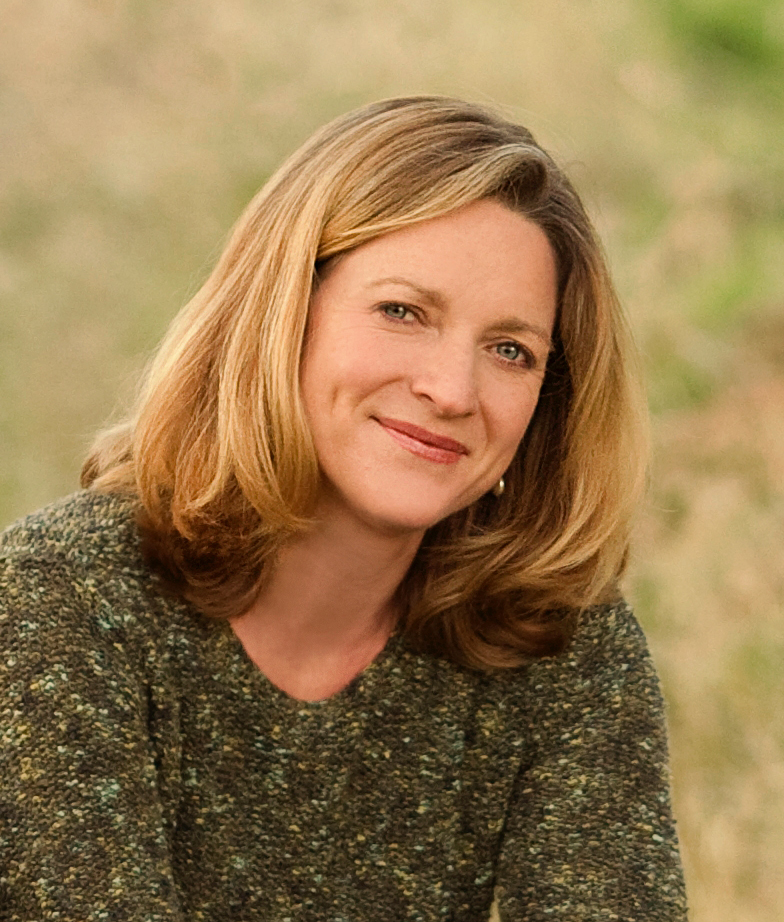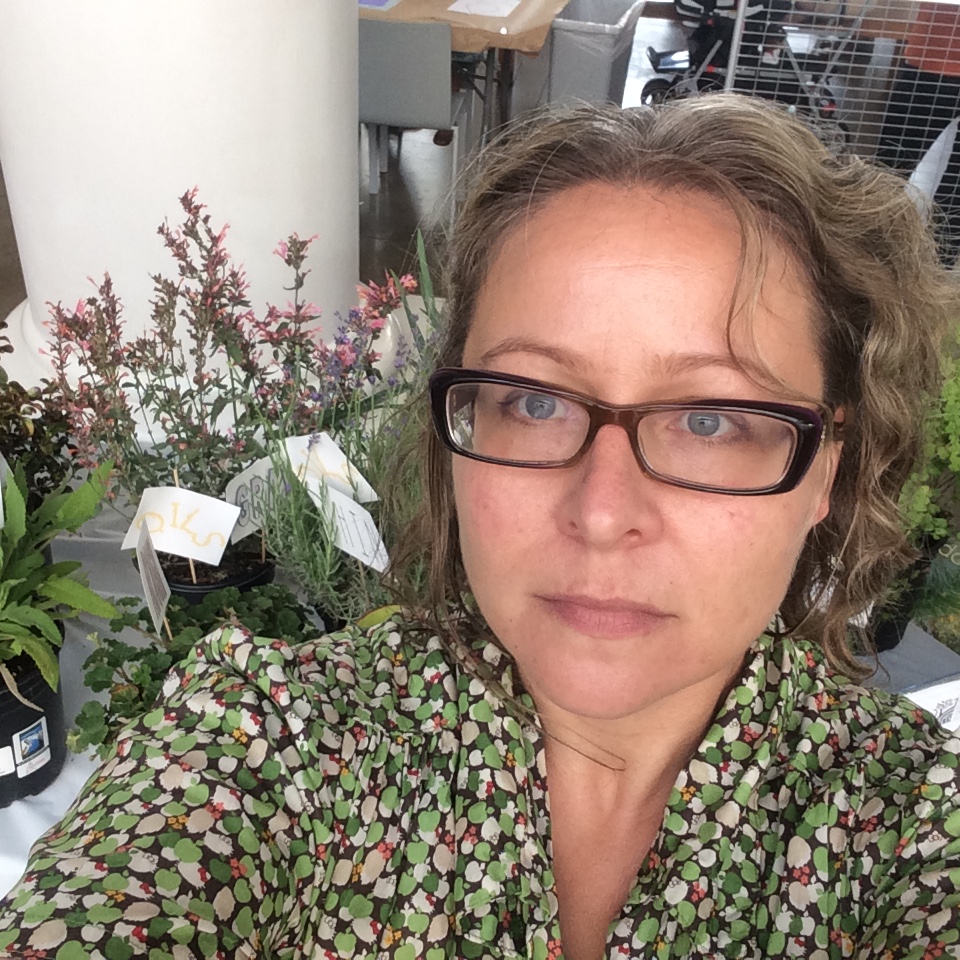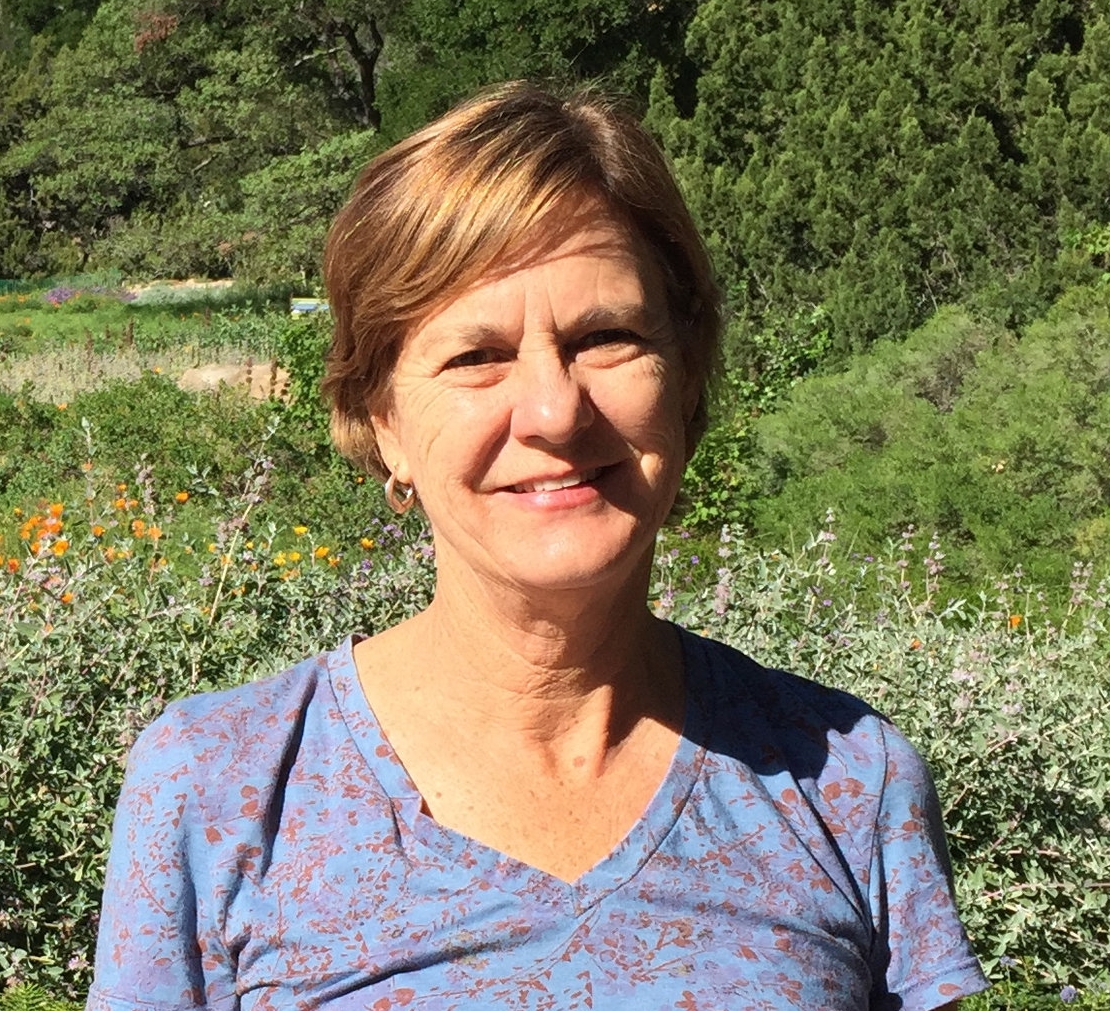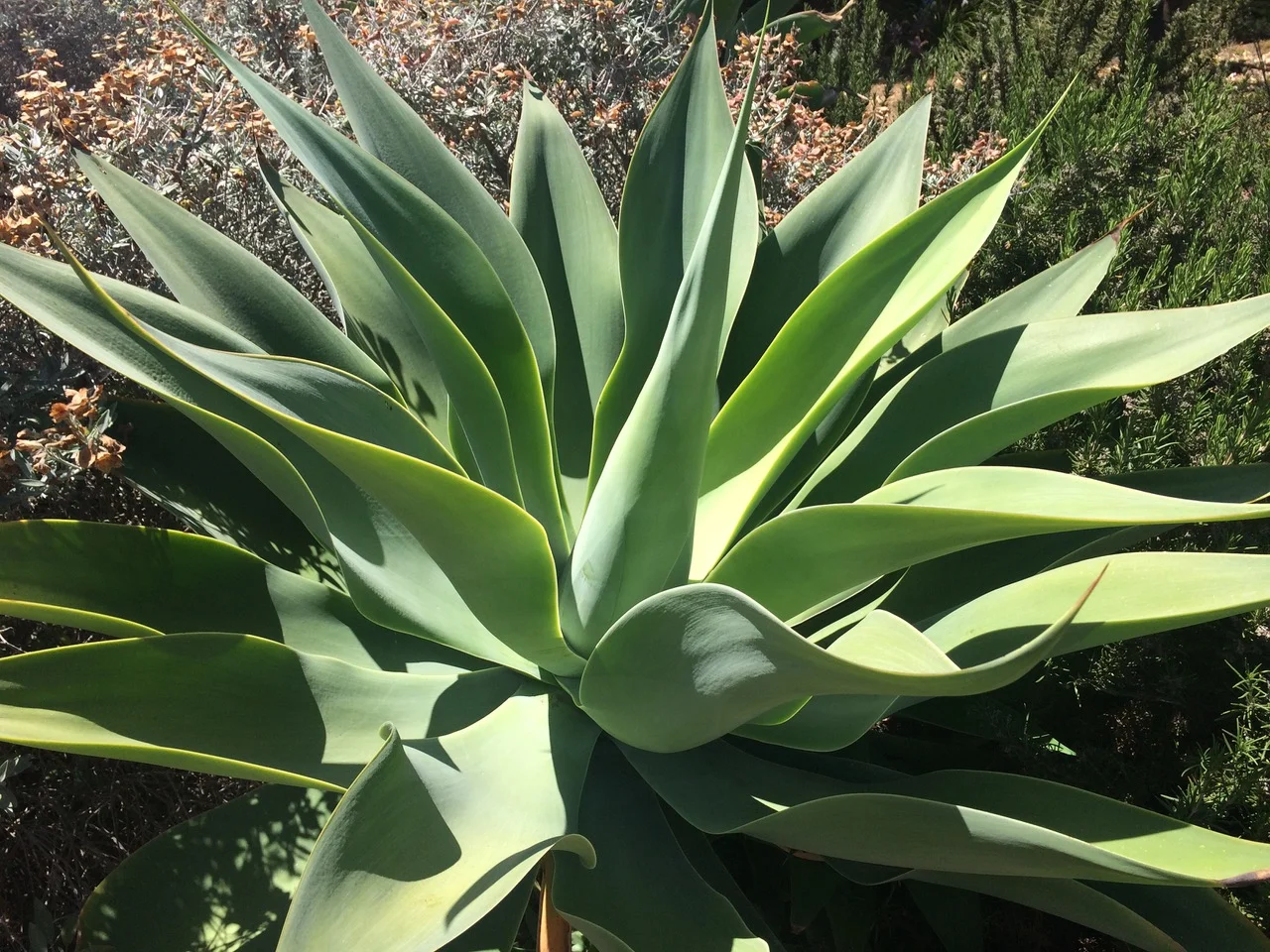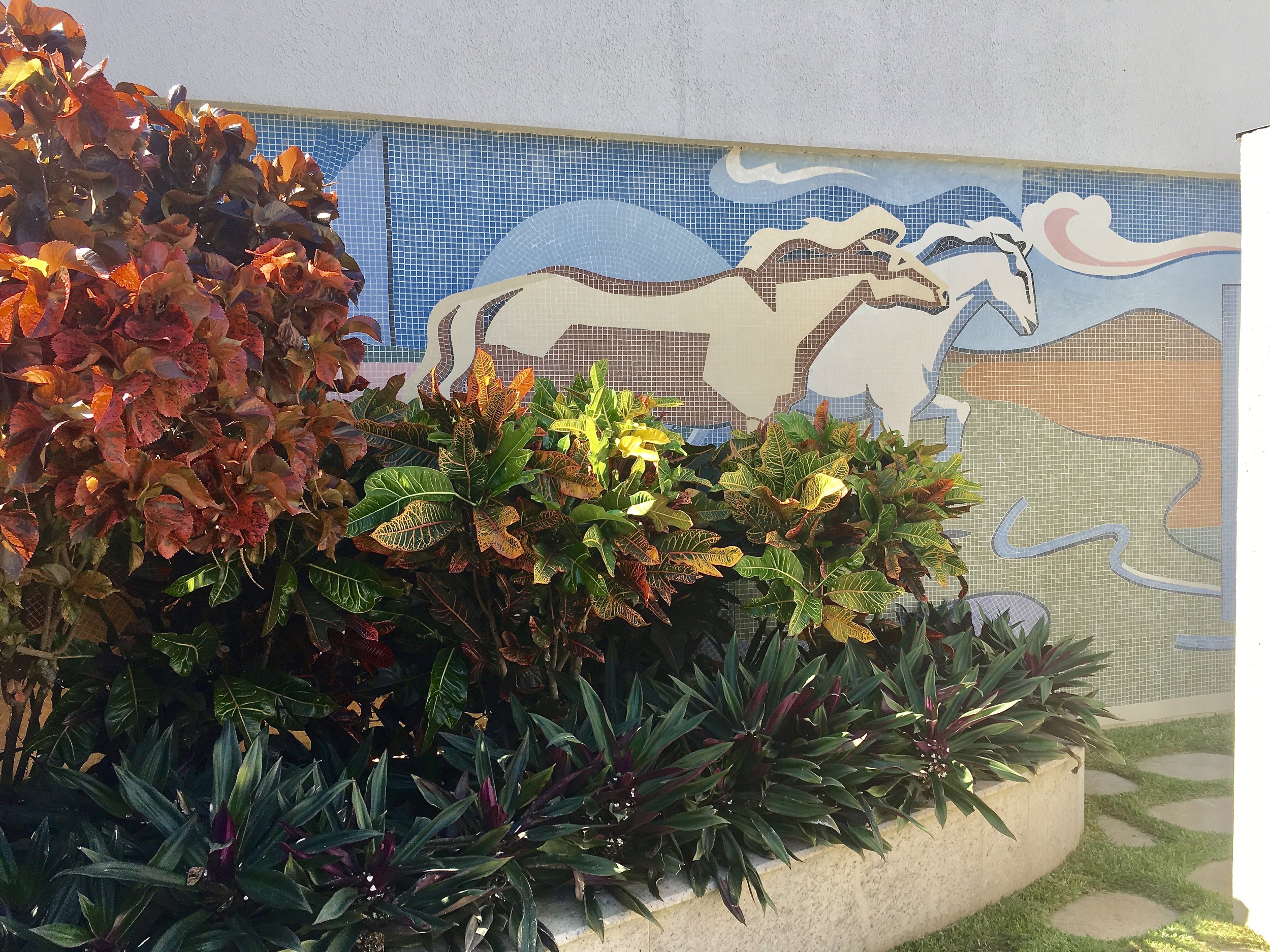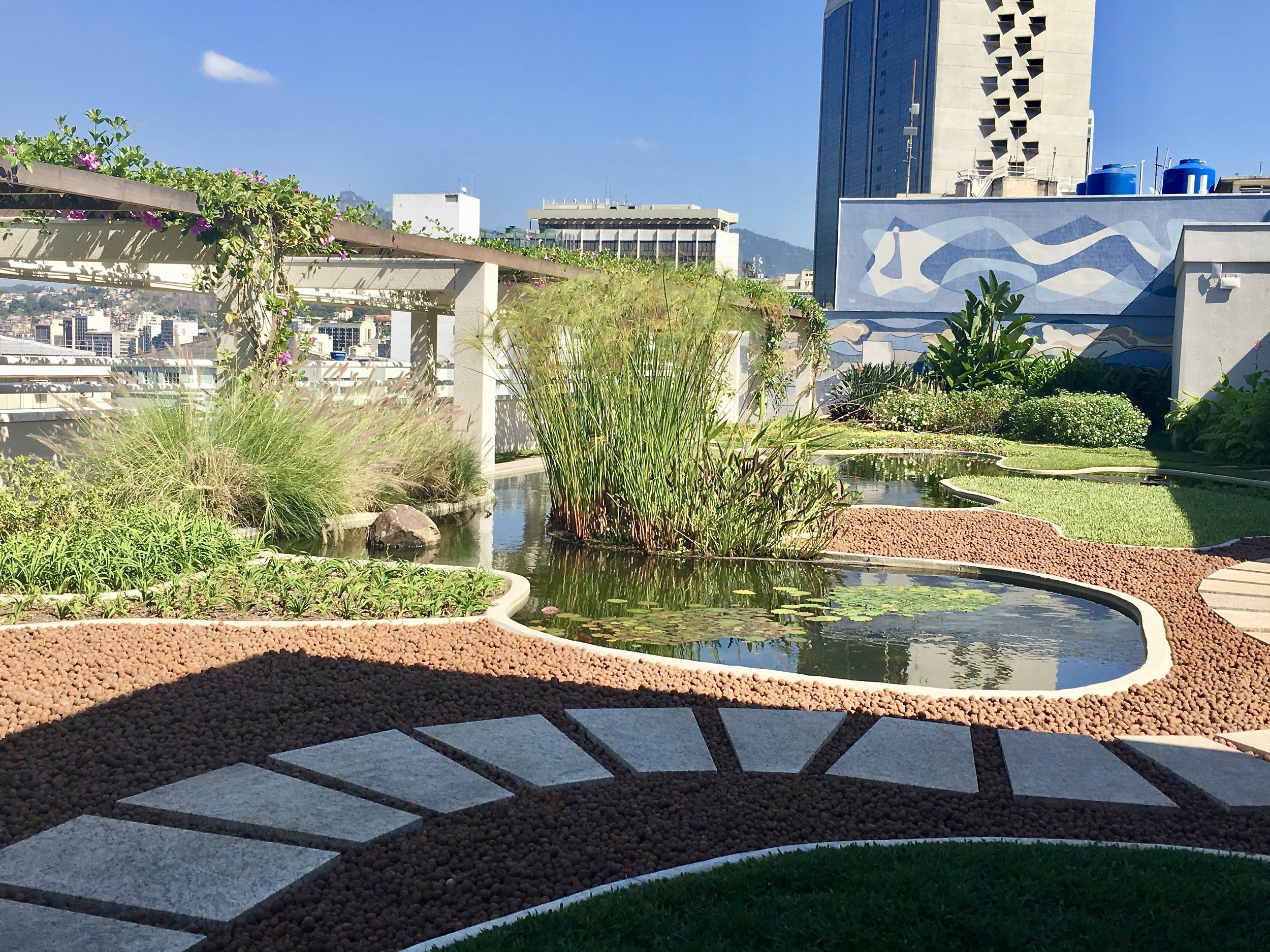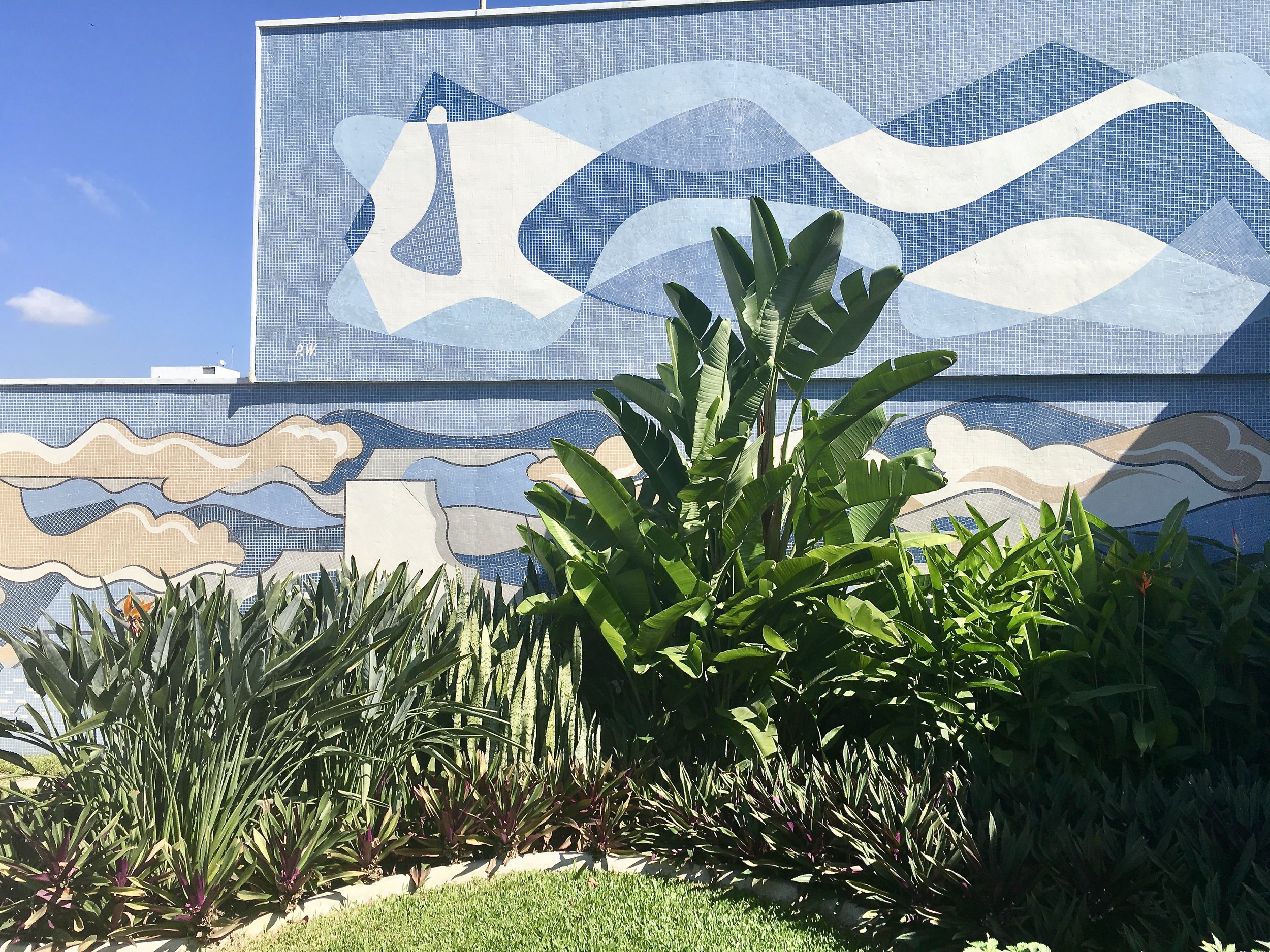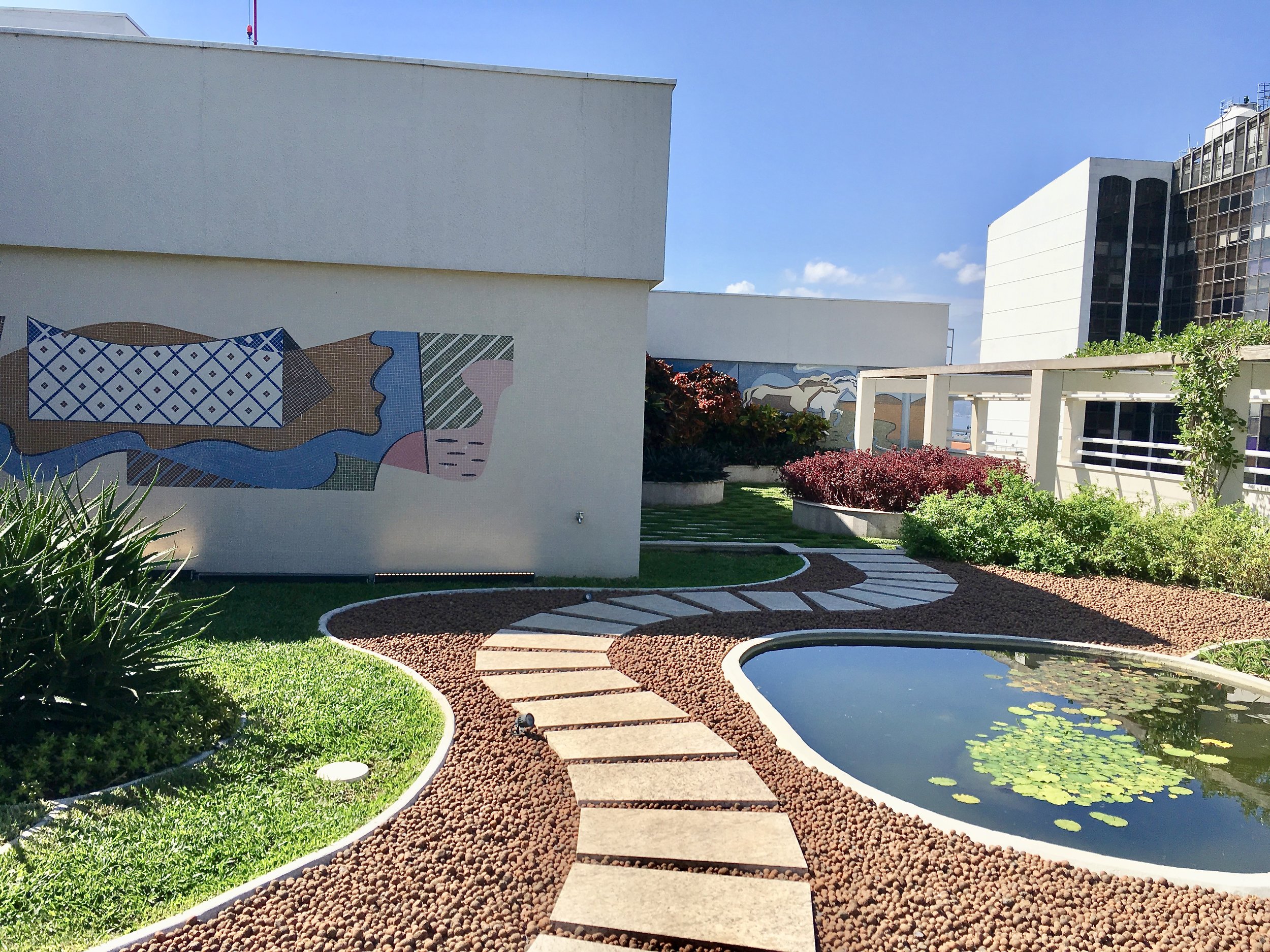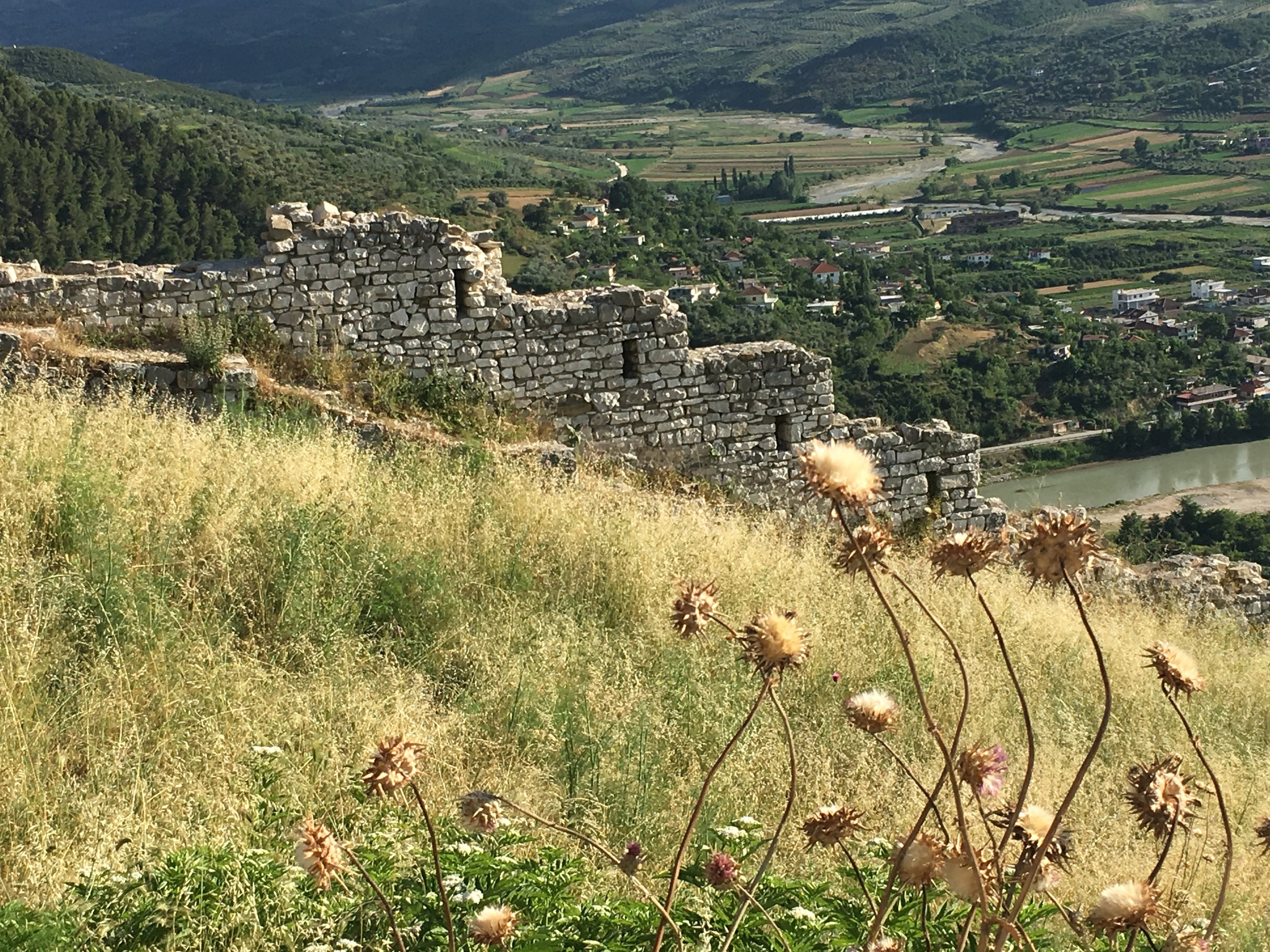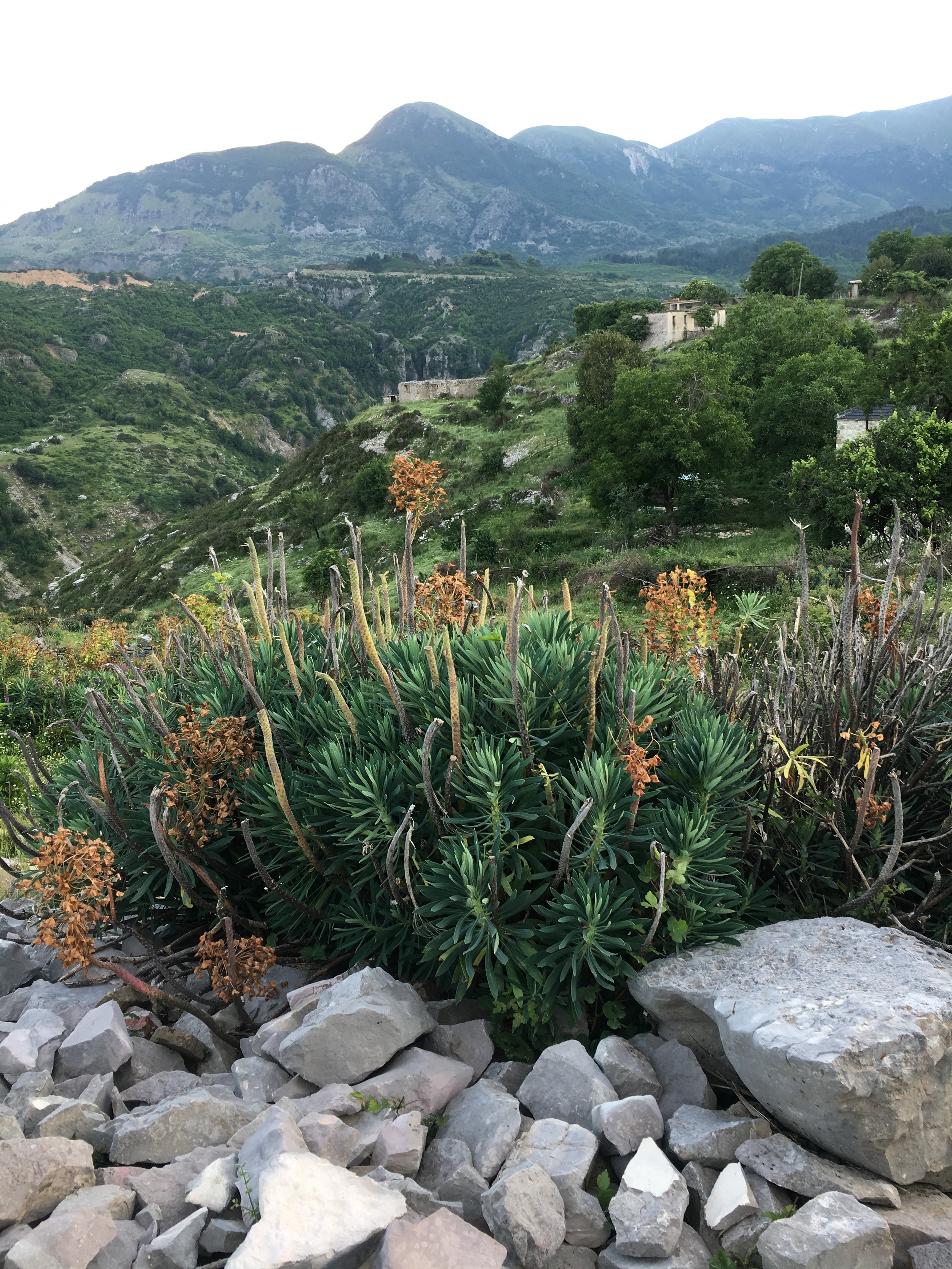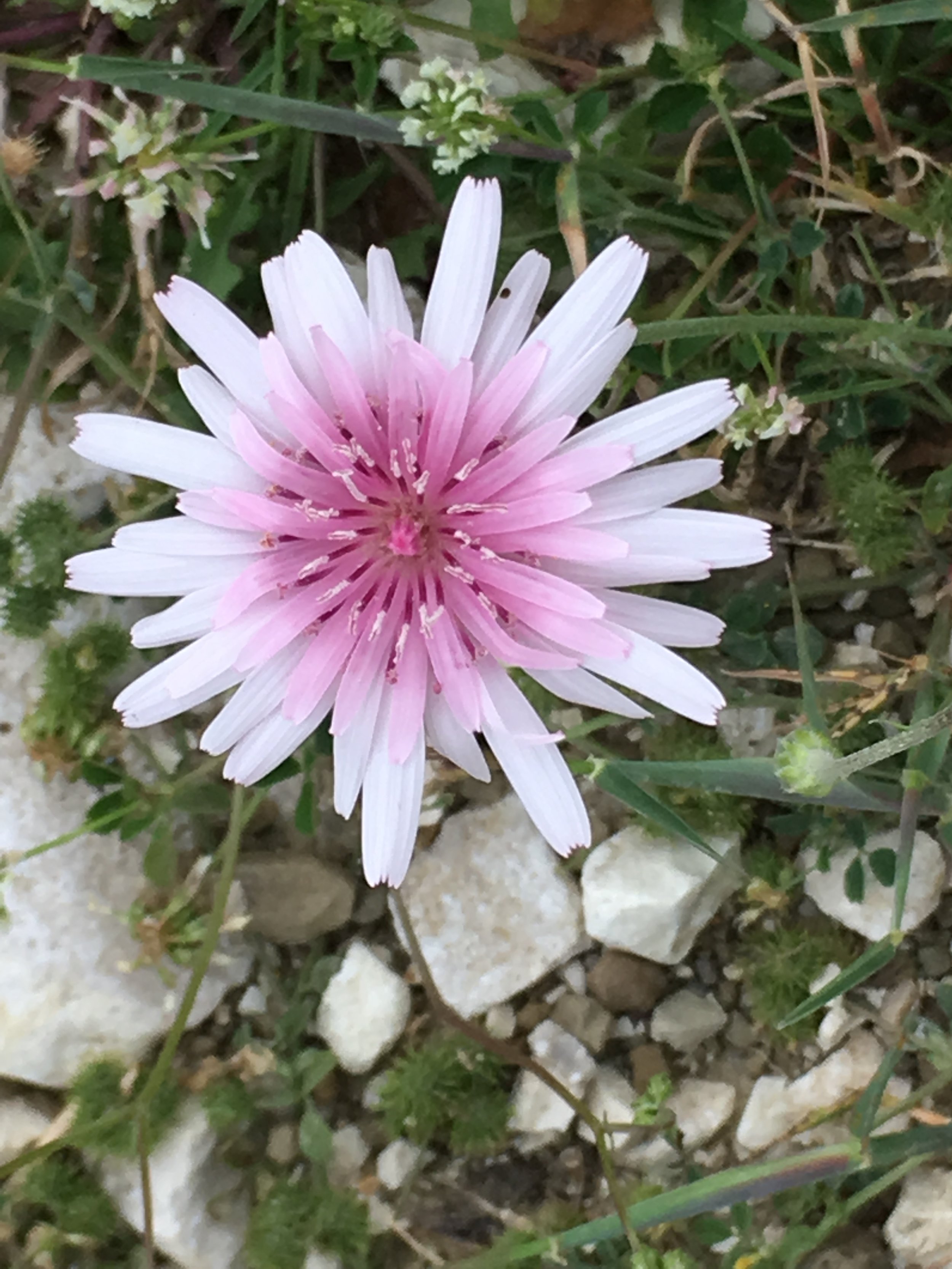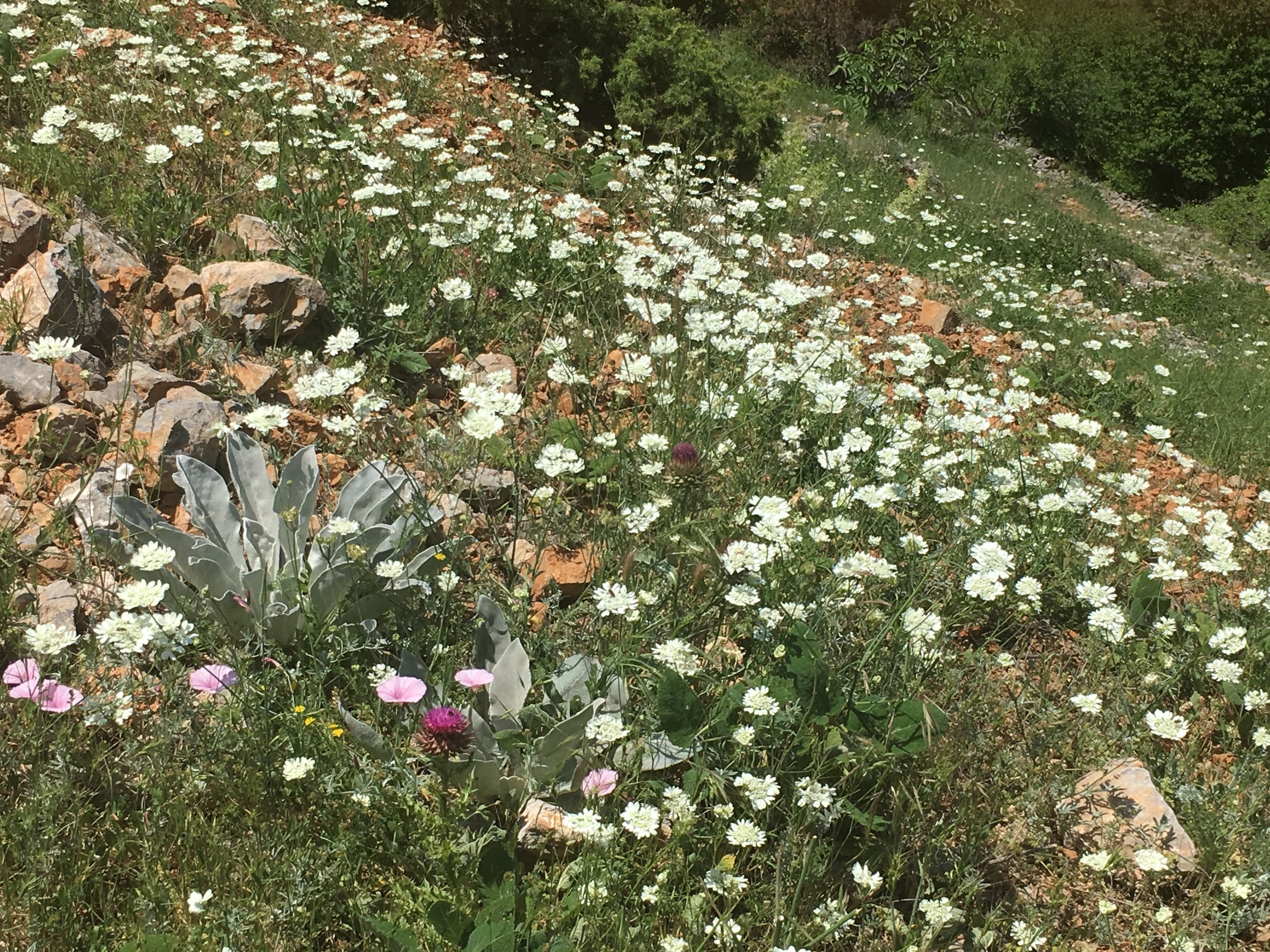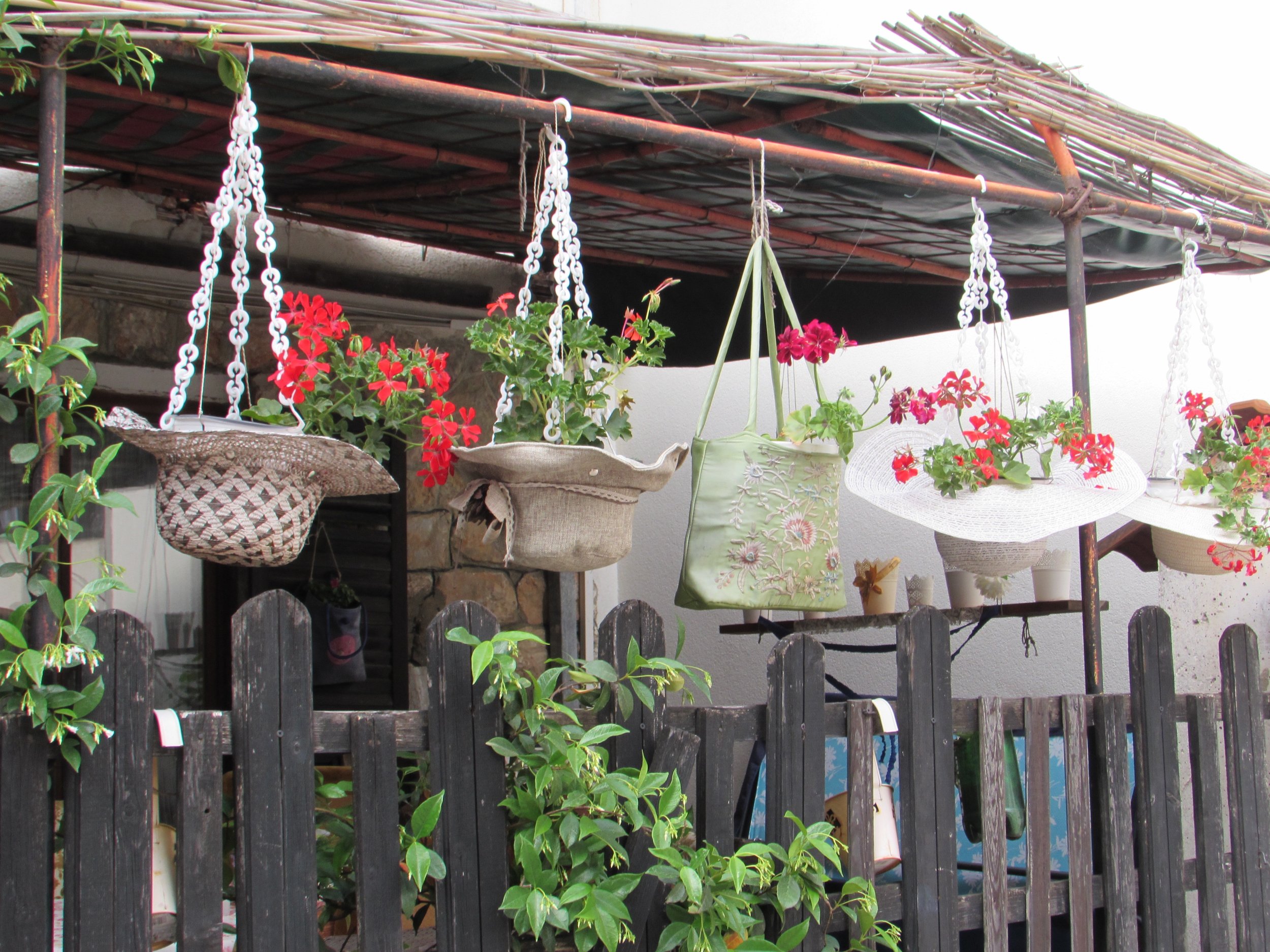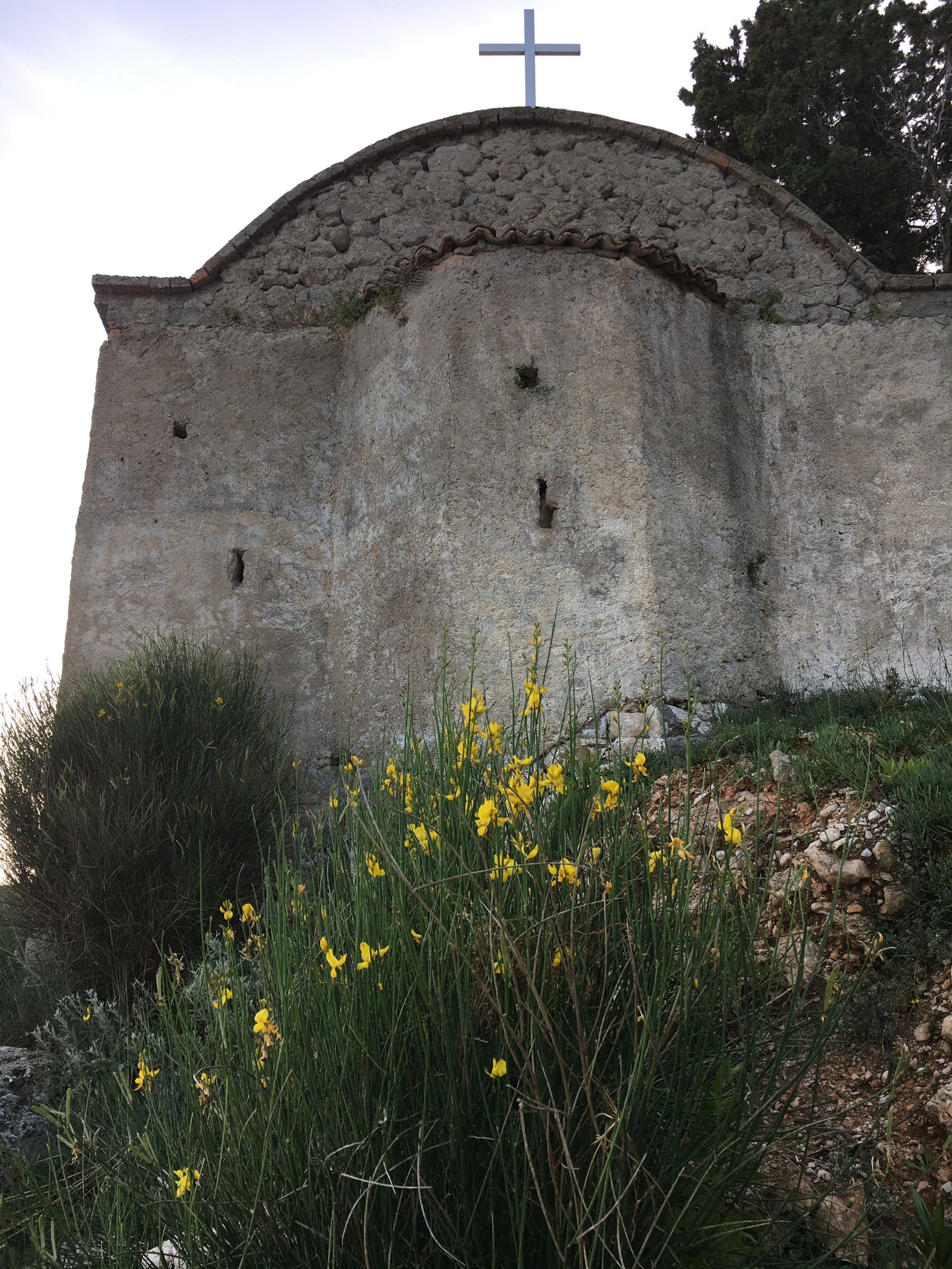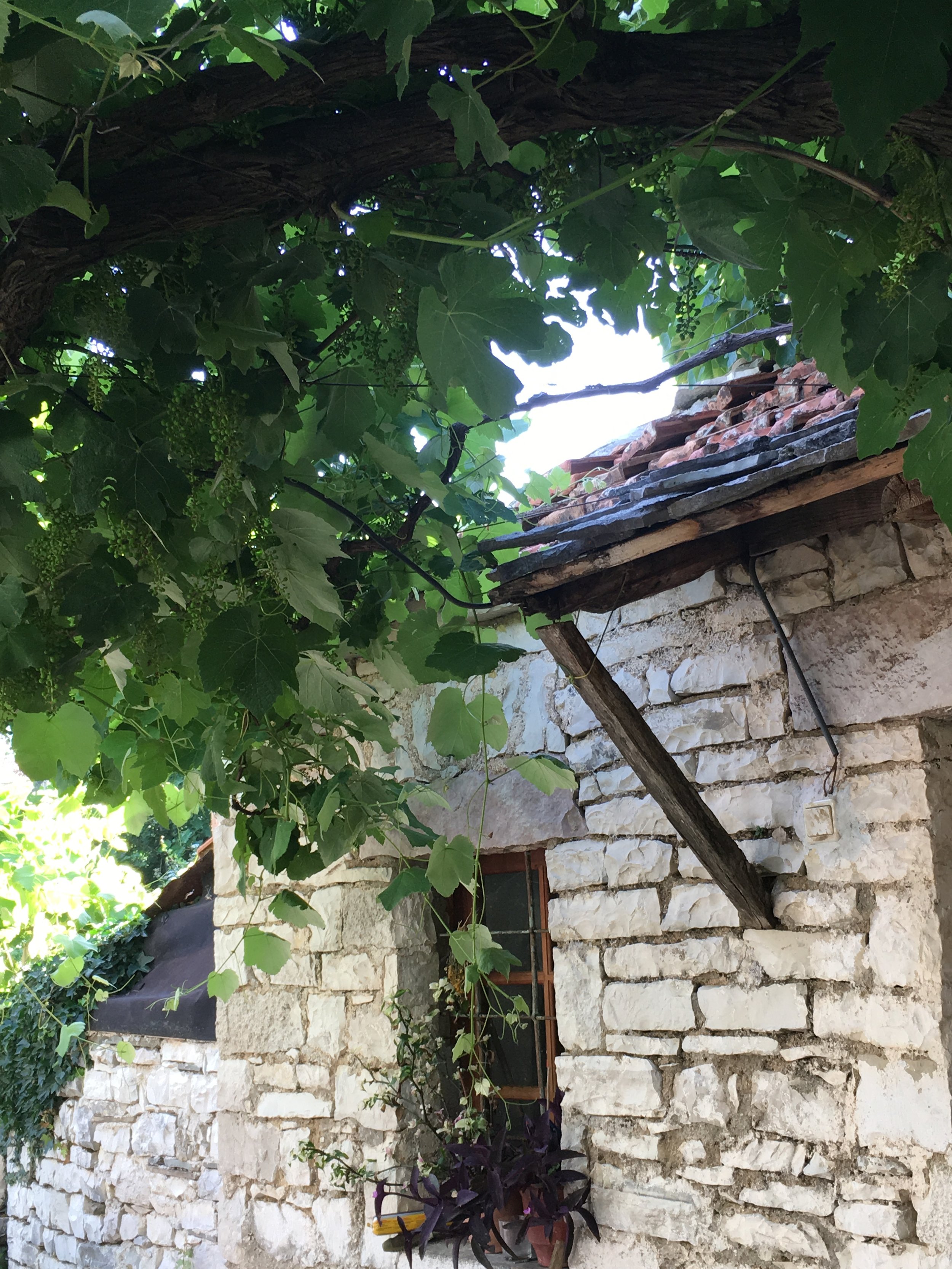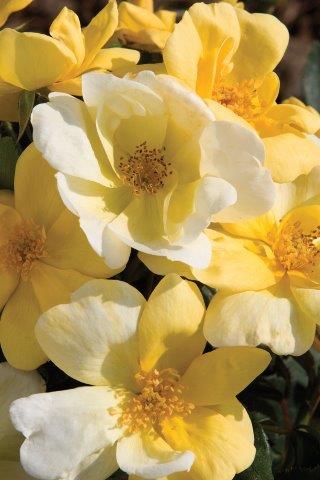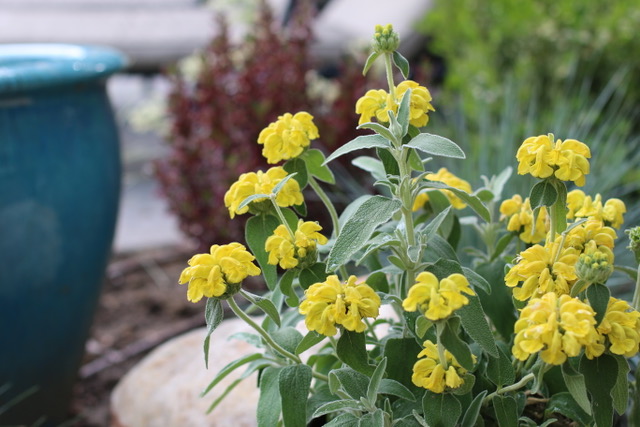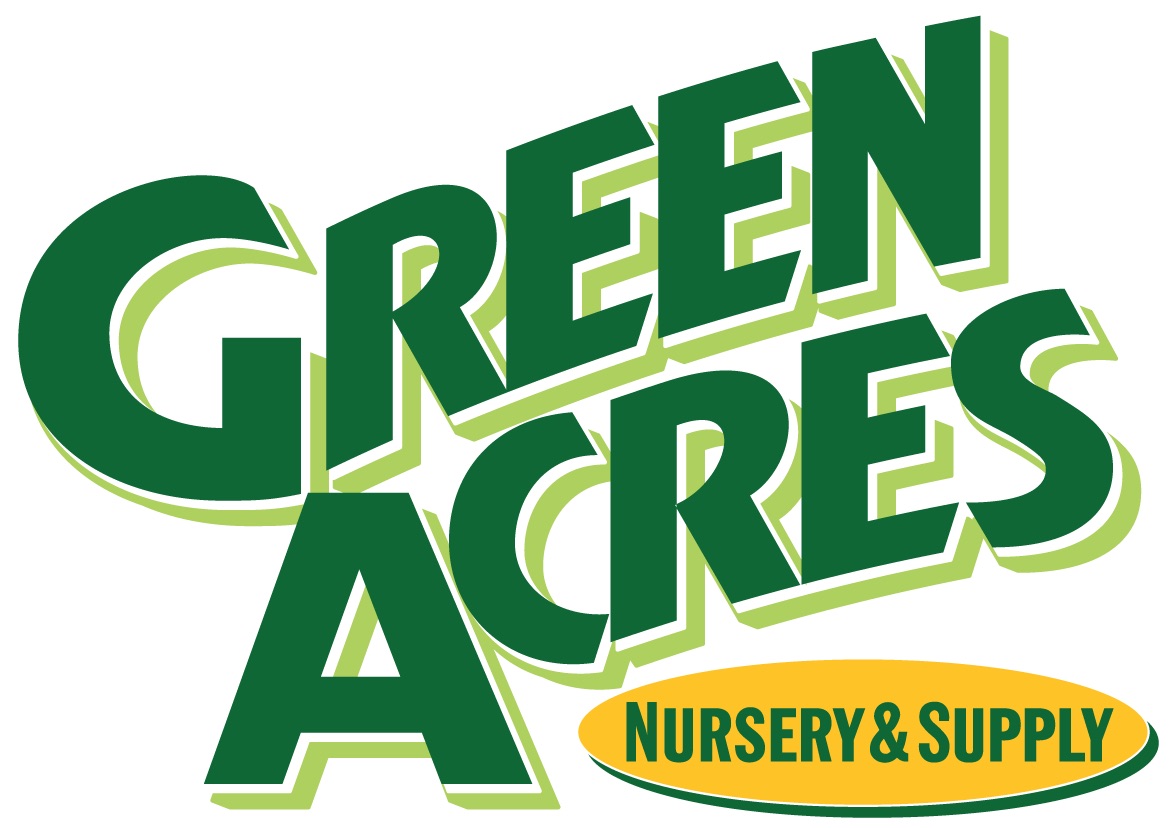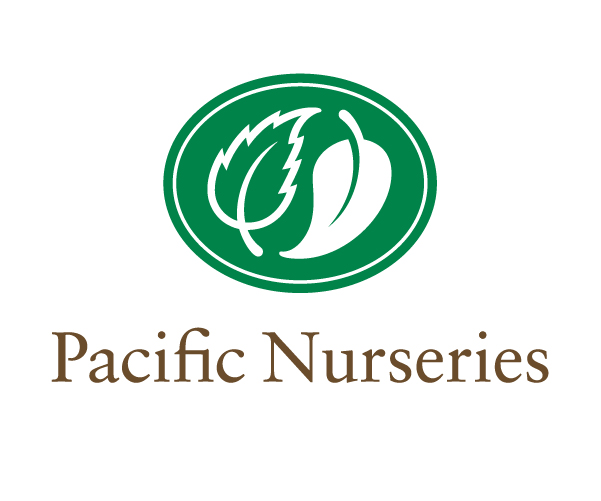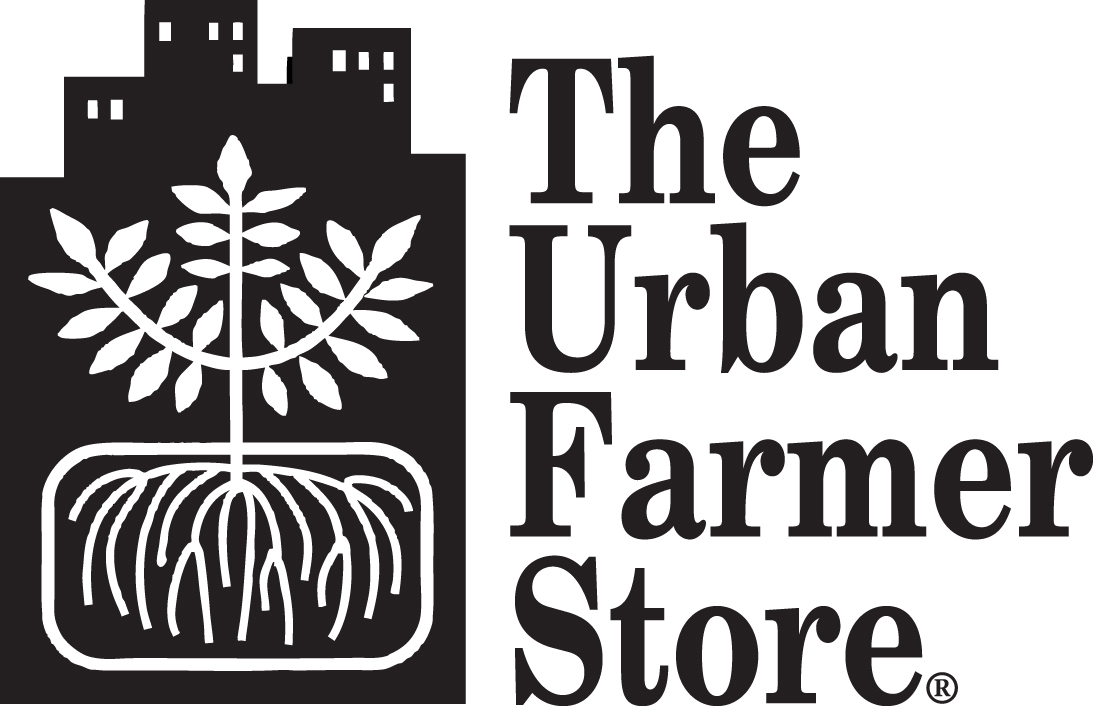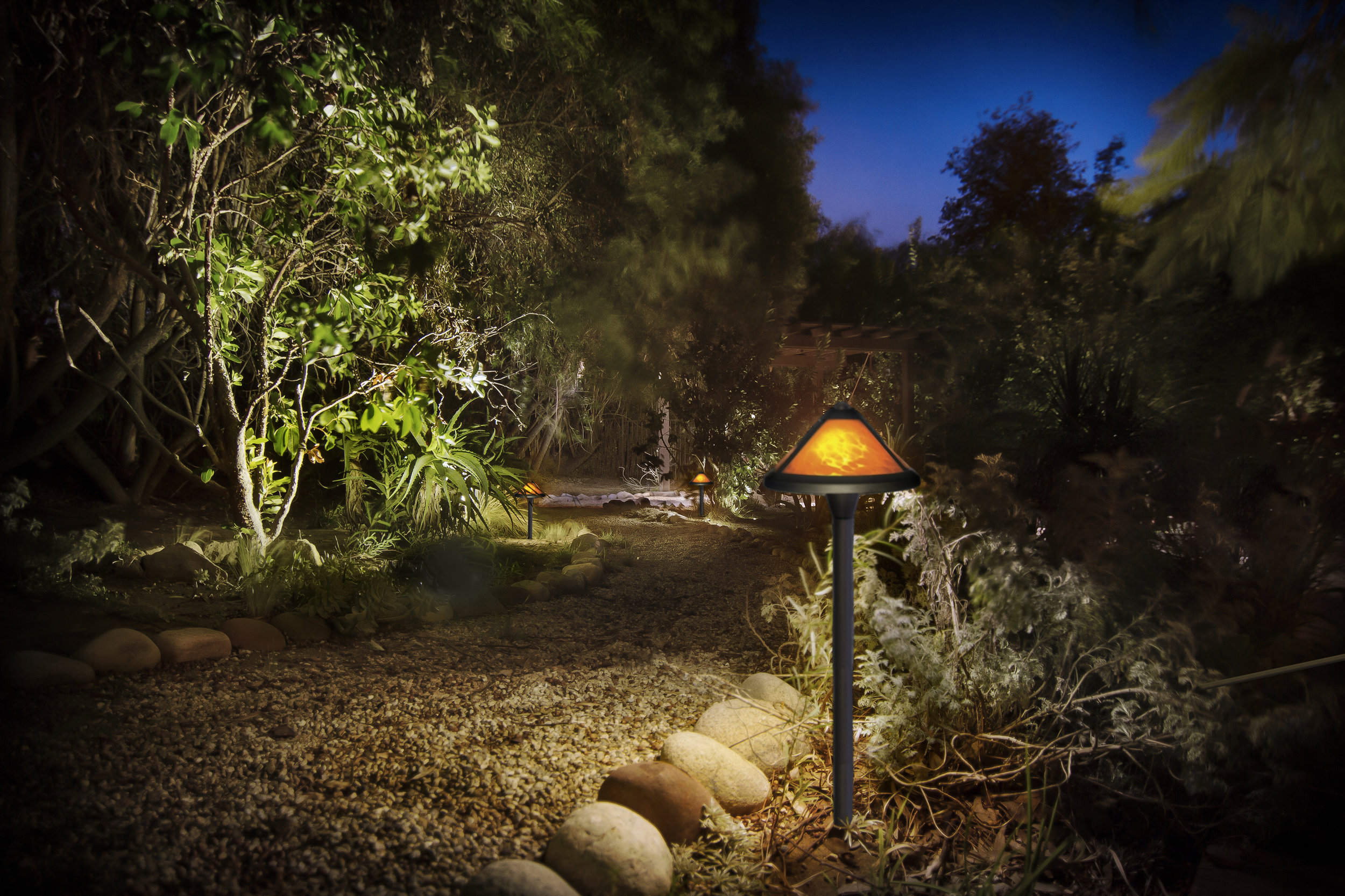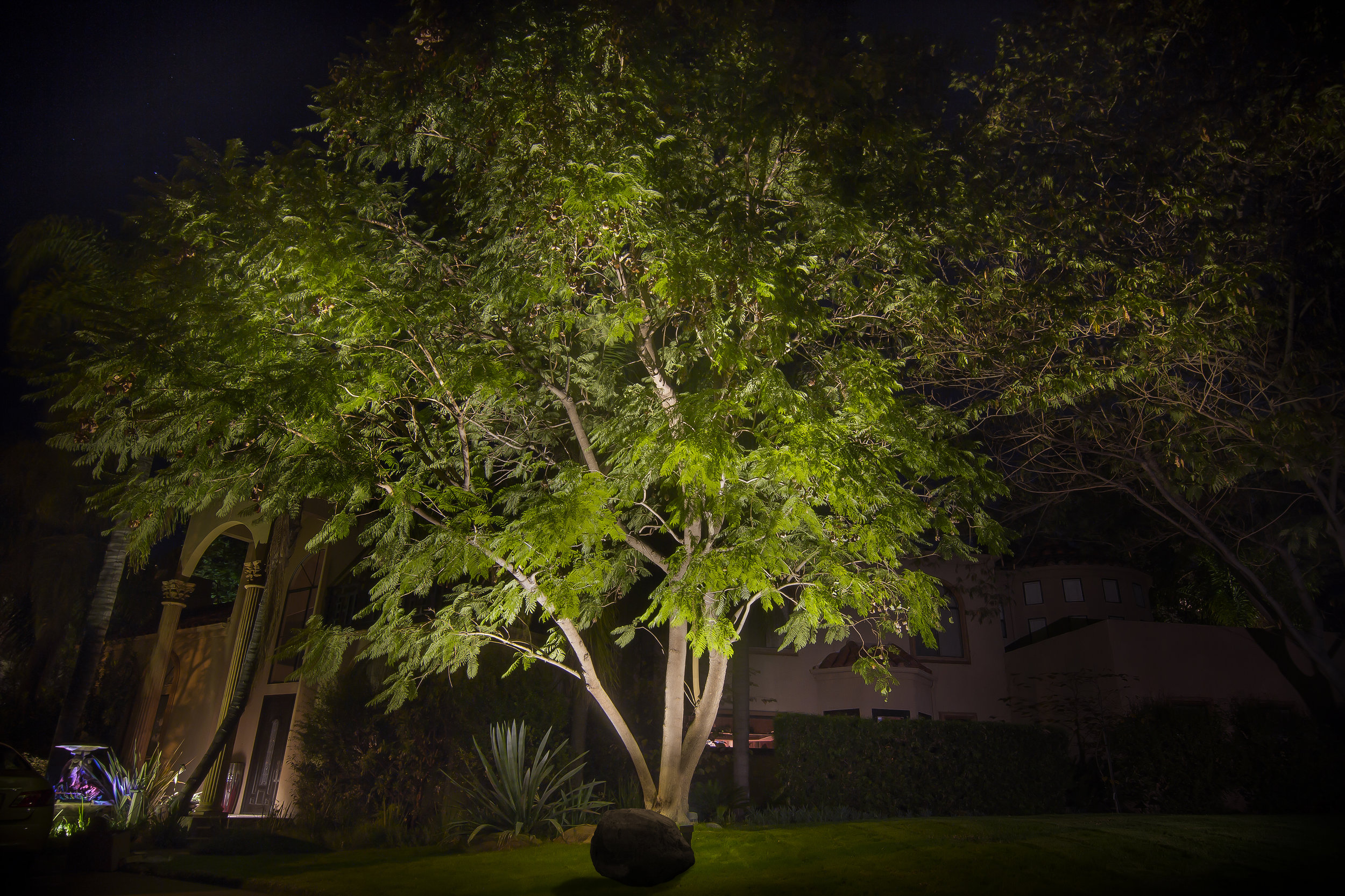Above photo from An Urban Meadow Garden, featured in The Designer's Toolbox. Photo courtesy of Jonathan Harnish.
Designing today’s gardens
FROM THE CHAPTER PRESIDENT
Francesca Corra, APLD
Greetings!
Welcome to the Summer 2018 "Focus on Flora" edition of California Landscape Design. Our love of plants might very well be the strongest tie that binds us all together. We wouldn’t be plant lovers, though, if we didn’t share other intrinsic qualities, such as generosity of spirit. Whenever I relate my story of how I came to be a landscape designer, I cannot leave this part out of my tale. My previous career as a corporate flight attendant was absolutely cutthroat. When I started designing, I joined APLD right away and was blown away by my fellow designers’ willingness to share and help in any way I needed and beyond.
It is with this spirit of generosity that I would like all of you to join me in congratulating the designers from California who have been chosen this year as winners of the APLD International Landscape Design Awards. The top award, Designer of the Year, was bestowed upon Margie Grace for her “Sycamore Canyon” garden. Margie also swept up gold for two other gardens and one in the silver category. A few years ago, a group of us in Southern California had the pleasure of visiting six of Margie’s gardens as part of our Santa Barbara garden tour. I see another tour in our future!
A big applause for the other California designers who received a silver award: John Beaudry, Debbie Gliksman, Mario Herrada, Brian Klein and Laura Morton. You can see pictures of all these gardens at apld.org.
I hope to see all of our California winners in attendance at the APLD International Design Conference in Toronto this September to accept their awards, and I encourage everyone to come and cheer them on! Conference details can be found at apld.org. If any California designer is thinking that they couldn’t relate to gardens in Toronto, I would encourage you to think otherwise. I have attended conferences so far in Boston, Washington DC and Santa Fe, and there is always an abbondanza of inspiration and takeaways from the gardens, the speakers, and social connections with designers from all over the world.
I would like to take care of one other matter of business before I leave you to explore everything about plants. Please do us a favor, and yourselves as well, by renewing your membership in a timely manner. When there is a time lapse, a lot of tedious work is involved to get you back up and running. This is done by both paid staff and by volunteers whose time and energy could be much better spent elsewhere…like shopping for plants!
Cheers!
Francesca Corra, APLD
APLD California Chapter President
CONTENTS
Simply scroll down to read the articles.
You may also click on the section titles below.
The Proof is in the Trials by Cheryl Buckwalter
A Day in Watsonville with the APLD Bay Area District
by Marcy Lotti-McCarrell
Catching up with APLD San Diego District by David Clarke, APLD
How To Effectively Light Plant Material by Lightcraft, an APLD CA Bronze Sponsor
Care and Maintenance of Natural Stone from Peninsula Building Materials, an APLD CA Gold Sponsor
Letter from the Chapter President
Francesca Corra, APLD
DESIGNER PLANT PICKS:
Members Share Their Current Favorite Plants
TOOLS AND TIPS:
An Urban Meadow Garden by Jonathan Harnish
FOCUS ON FLORA:
Useful Plant Lists for Special Situations
BOOK REVIEW:
Garden Revolution reviewed by Francesca Corra, APLD
DESIGNER PROFILE:
Max Kanter by Catherine McLaughlin
BEYOND CALIFORNIA:
A Rooftop Jewel in Rio de Janeiro by Amelia Lima, APLD
Flora Highlights of Macedonia by Debbie Gliksman, APLD
Above photo courtesy of Francesca Corra, APLD.
DESIGNER PLANT PICKS:
Members Share Their Current Favorite Plants
As professional landscape designers, we strive to select plants that are adapted to the local climate zone and to use local native plants whenever possible. These low-water workhorses deliver many benefits, and when they do require irrigation, they are able to thrive on low water inputs. For more information about APLD and the watershed approach, please visit our website at apldca.org.
Below you will find the favorite climate appropriate plants of California APLD members.
Tina Henricksen
Tina Henricksen Garden Design, Roseville, CA
APLD Sacramento District Vice President & CA Chapter Secretary
Photo courtesy of Devil Mountain Wholesale Nursery.
Euphorbia ‘Blackbird’
BLACKBIRD SPURGE
"Its beautiful rich, dark purple foliage adds drama and flair to the garden and provides colorful contrast to a planting scheme. ‘Blackbird’ is lovely in and out of flower, but stunning when its red stems sporting bright green bracts open to lime green flowers. It draws the eye and invariably leads to the question, 'what is that plant?!'"
Johanna Woollcott
Wild Gardens, Los Angeles, CA
APLD Greater LA District President
Photo courtesy of Johanna Woollcott.
Dendromecon harfordii
ISLAND BUSH POPPY
"This is a wonderful evergreen native shrub that adds a happy sparkle to any garden! If in full sun it will get to its maximum size. But if in part sun, it will keep an airy open styling that is lovely. The silvery glaucous blue leaves add a wonderful contrast to deep greens and the sunny, clear yellow blooms are noted to be Winter-Spring but I find them constant thru at least 3 seasons!"
David Clarke, APLD
David Clarke Design, San Diego, CA
APLD San Diego District President
Photo courtesy of David Clarke, APLD.
Santolina chamaecyparissus
LAVENDER COTTON
"I use this drought-adapted subshrub as a fragrant border and fill-in plant for Mediterranean style gardens. It spreads fairly easily, has a nice soft gray color and texture, and the summer blossoms are a bright sunny yellow. Very nice with rounded boulders, flagstone, and even birdbaths! Good transition species for rock gardens, too."
Cathy Edger
Edger Landscape Design, Grass Valley, CA
APLD Sacramento District Member
Photo courtesy of Cathy Edger.
Salvia clevelandii ‘Aromas’
AROMAS CLEVELAND SAGE
"This sage has many virtues: once established it needs no supplemental water, has a wonderful fragrance, and statuesque lavender flowers in late spring. It works beautifully in front of darker shrubs and behind other short colorful perennials. For clients who are interested in creating wildlife habitat, wonderful russet- colored spent flower heads need not be deadheaded until it is time for early winter pruning."
Laura Morton, APLD
Laura Morton Design, Los Angeles, CA
APLD Greater Los Angeles District Member & CA Chapter Sponsorship Chair
Photo courtesy of San Marcos Growers.
Grevillea ‘Moonlight’
"I’m loving this as a loose hedge or screening. It’s a lovely change from green to have that silvery lacy foliage and the surprise of such a large creamy flowers. It works so well with Dianellas too."
Martin Carrion van Rijn
Landscape Symphonies, Oregon House, CA
APLD Sacramento District President
Photo courtesy of Devil Mountain Wholesale Nursery.
Rhamnus californica ‘Mound San Bruno’ SAN BRUNO COFFEEBERRY
"This is a tough native shrub that I have used with great effect in several projects. It is very easy going – doing well in sun & shady conditions – and looking nice year round."
Tina Roushall
Roushall Gardens, San Mateo
APLD Bay Area District President
Photo courtesy of Devil Mountain Wholesale Nursery.
Sesleria autumnalis
AUTUMN MOOR GRASS
"Nice evergreen clumping grass, sun or (part) shade, and good substitute for Carex divulsa when a WUCOLS medium water plant can be used."
Michal Commanday
Garden by Michal, Walnut Creek, CA
APLD Bay Area District Member
Photo courtesy of San Marcos Growers.
Melaleuca incana
GREY HONEY MYRTLE
"The weeping habit of this Australian shrub or small tree would make a fine specimen plant, but it also shows nicely in front of coarser, darker foliage shrubs, with its fine grey foliage and poofy little yellow bottle brush-shaped flowers. The deer don’t touch the plant, and it seems to do fine with little or regular water."
Kathleen Olson
Kathleen’s Garden Landscape Design, Lafayette, CA
APLD Bay Area District Member
Photo courtesy of Sunset Western Garden Collection.
Cistus ‘Little Miss Sunshine’
LITTLE MISS SUNSHINE ROCKROSE
"An excellent size for smaller gardens or for repeating in the landscape, with beautiful yellow/chartreuse foliage and a nice, neutral white flower."
BJ Ledgerwood
Native YardScape, Walnut Creek, CA
APLD Bay Area District Member
Photo courtesy of San Marcos Growers.
Fremontodendron californica ‘Dara’s Gold’
FLANNEL BUSH
"I love this plant for dry sunny slopes. Low growing and spreading with handsome evergreen foliage. It flowers in late spring with sporadic blooms during the year. Great composition plant with other California native plants that like zero to occasional watering after the first couple of seasons."
Maryanne Quincy, APLD
Q Gardens Landscape Design, Sunnyvale, CA
APLD Bay Area District Board Secretary
Photo courtesy of Village Nurseries.
Salvia greggii
AUTUMN SAGE
"So many different colors of Salvia greggii’s – blues, purples, reds, pinks and soft yellow. Long bloom that attracts hummingbirds!"
Katie Creighton
Katie Creighton Garden Design, Oakland, CA
APLD Bay Area District Member
Photo courtesy of Devil Mountain Wholesale Nursery.
Grevillea lanigera
‘Coastal Gem’
WOOLLY GREVILLEA
"This evergreen plant has a unique texture and shape, adding interest to the garden year round, but especially in winter/early spring when it blooms its head off with tiny pink curly cue flowers. It can be used to cover open hillsides, or as one-of-a-kind in smaller gardens. Loves sun and very drought tolerant."
Kristin Caldwell
Kristin Caldwell Garden Design, Moraga, CA
APLD Bay Area District Member
Photo courtesy of San Marcos Growers.
Cotyledon orbiculata var. oblonga ‘Flavida’
FINGER ALOE
"I like this plant because of its interesting texture (think finger grass) and white chalky leaf color. The coral orange bloom stands out amongst the foliage in spring and so easy to cut off some stems and start in other parts of the garden."
Anna Wendorf
Anna Wendorf Design, Concord, CA
APLD Bay Area District Special Events Chair
Photo courtesy of Devil Mountain Wholesale Nursery.
Ceanothus 'Valley Violet'
VALLEY VIOLET WILD LILAC
"Ceanothus is often too large for the average garden. This one stays compact at 2'x4', and blooms profusely."
Laura Henry Kukulski
Laura Henry Design, Oakland, CA
APLD Bay Area District Communications Chair
Photo courtesy of Devil Mountain Wholesale Nursery.
Leucadendron ‘Ebony’
EBONY CONEBUSH
"This 4’x5’ shrub has beautiful black/burgundy foliage and standout red bracts. It can be used as a specimen or to create a dark background for brighter plants. This should be a go-to plant for all your goth garden designs."
John Black
Verdance Landscape Design, Palo Alto, CA
APLD Bay Area District Member
Photo courtesy of Devil Mountain Wholesale Nursery.
Agave x ‘Blue Glow’
BLUE GLOW AGAVE
"I love this Agave for its compact form, the red edging on its blue-gray leaves, and the fact that it needs almost no water but won’t sulk in a garden setting either."
Patricia St. John, APLD
St. John Landscapes, Berkeley, CA
APLD Bay Area District Member
Photo courtesy of Devil Mountain Wholesale Nursery.
Arctotis ‘Ruby Creeper’
RUBY CREEPER AFRICAN DAISY
"This Arctotis, with its magenta/ruby daisy-like flowers, creeps along the ground about 1’ high and 2-3’ wide. It’s evergreen foliage is a grey-green tomentose lobed leaf that looks good year round—great for a parking strip mixed with Gazania and grey festucas."
TOOLS AND TIPS:
An Urban Meadow Garden
by Jonathan Harnish
InSite Landscape Design
APLD Greater Los Angeles District Member
In designing this sustainable urban meadow garden in the Cheviot Hills neighborhood of Los Angeles, my goal was to transform a desolate front yard lawn into a low-maintenance, naturalistic space that conserves water, provides valuable habitat for beneficial pollinators, and offers captivating aesthetic appeal.
While meadow-style planting may appear spontaneous and haphazard, this meadow garden is organized with a series of carefully choreographed transitions and combinations of ornamental grasses and flowering perennials that create defined spaces within the garden. These spaces—each with their own distinct character and design intent—are both separated and unified by a serpentine drift of Carex pansa that meanders throughout the garden and produces negative space.
In developing the plant palette for this garden, I considered several factors, including the site topography, location, background elements, and lighting. To account for the relatively small scale of the space and low-maintenance requirements, I selected shrubs that generally don’t grow too large and can be layered well with grasses and groundcover. Aesthetically, I choose to make this simple, yet complex meadow more readable by limiting the foliage and flower color scheme to shades of purple, green, gray, and white. I also selected plants with seasonal interest that interact well with wind, light, and shadow.
In particular, the non-invasive Pennisetum ‘Fairy Tales’ cultivar provides stunning late afternoon interest in the spring and summer, when the backlighting of the sun makes its abundant foxtails glow like candles. Likewise, Salvia ‘Mystic Spires Blue’ blooms nearly year-round in Southern California and produces vivid deep blue upright blooms that rhythmically undulate in the wind and shimmer in the late afternoon light, especially when massed and layered with complimentary plants sharing similar form, such as Lavandula ‘Goodwin Creek’.
To help attract native pollinators—particularly birds and butterflies—I integrated California native flowering perennials, such as Achillea millefolium and Verbena iliciana ‘De La Mina’, and seed-producing sedges, including Carex tumulicola and Carex pansa.
Photos courtesy of Jonathan Harnish.
URBAN MEADOW GARDEN PLANT LIST
BLOOMING PERENNNIALS
Salvia ‘Mystic Spires’ MYSTIC SPIRES BLUE SAGE
Lavandula angustifolia ‘Munstead’ MUNSTEAD ENGLISH LAVENDER
Lavandula ‘Goodwin Creek’ GOODWIN CREEK GRAY LAVENDER
Lavandula stoechas ‘Otto Quast’ OTTO QUAST SPANISH LAVENDER
Verbena lilicina ‘De La Mina’ CEDROS ISLAND VERBENA
ORNAMENTAL GRASSES
Carex pansa CA MEADOW SEDGE
Carex tumulicola FOOTHILL SEDGE
Pennisetum ‘Fairy Tales’ EVERGREEN FOUNTAIN GRASS
Pennisetum ‘Little Bunny’ LITTLE BUNNY DWARF FOUNTAIN GRASS
GROUNDCOVERS
Cerastium tomentosum SNOW-IN-SUMMER
Achillea millefolium COMMON YARROW
Nepeta fasssenii ‘Walker’s Low’ WALKER’S LOW CATMINT
FOCUS ON FLORA:
Useful Plant Lists for Special Situations
by Suzanne Arca, APLD, ASLA, CLCA
Arca Design Group, Albany, CA
APLD Bay Area District Member
Plants We Love to Espalier
For nearly 40 years Suzanne Arca has been designing, building and maintaining beautiful residential and commercial landscapes in the San Francisco Bay Area. Suzanne has shared her knowledge with others as a lecturer at Merritt College and the UC Extension Landscape Architecture Department.
Suzanne’s desire to make the most of every square inch of planting space in the many small urban gardens she has designed, lead her to experiment with the ancient art of espalier (training woody plants against a flat surface). Here are a few of her favorite plants to espalier.
by Yael Ehrenberg Hellion
verde360, San Francisco, CA
APLD Bay Area District Member
Green Density for Wall Gardens
Yael Ehrenberg Hellion is the co-founder and principal designer for Verde360, a landscape design firm in San Francisco and Mexico City. In 2007, together with two friends, an architect and an industrial designer, she started her own landscape design and build studio in Mexico City, specializing in vertical gardens. In the last ten years their studio, Verde360, has produced a great number of vertical gardens ranging in sizes from 64 sf to 30,000 sf.
"I can say it is a challenge to create a dynamic design with plants of different textures, colors and growth habits in the same artificial environment on a vertical plane. But I have found out that there are plants which spread and grow more easily on a green wall and that are very helpful to use in combination with other accent plants to create "green density" and to fill in spaces on the vertical garden that otherwise would look more sparse. I came up with a list of some of my favorite plants for green walls here in California, many of which I have also used in my projects in Mexico. "
by Cynthia Tanyan
Mozaic Landscapes, Sunol, CA
APLD Bay Area District Member
The Toughest of the Tough: Plants for Greenroofs
For 20 years, Cynthia Tanyan has designed over 500 varied residential gardens throughout the SF Bay Area and beyond, including a master plan for a Stanford Lands horsepark, a rural cemetery in Massachusetts, a Native American sculpture garden, and an extensive modern greenroof.
Cynthia's designs have been featured in Sunset (she is a recipient of Sunset's "Best in the West" and "Dream Gardens" Award) and People magazine. Her designs can be seen in The American Meadow Garden, by J. Greenlee (c.2009), and Reimagining the California Lawn, by C. Bornstein.
"Greenroofs are tough environments for plants as they are usually exposed to all-day sun, wind, drought conditions and have only a shallow root zone. This is similar to native conditions for many rock garden and succulent plants. Sedums of all kinds are the mainstay for greenroofs. Choose plants that are tough, stay fairly low to the ground, and don’t require much deadheading or other maintenance."
by Marilee Kuhlmann
Urban Water Group, Inc., Santa Monica, CA
APLD Greater Los Angeles District Member at Large
Beyond Juncus: Fresh Planting Ideas for
Rain Gardens
Marilee Kuhlmann has committed herself to improving the landscape of Los Angeles. She sees potential, applies alternative, responsible, sustainable principles and develops projects that consider land stewardship, potential local impact, water conservation, soil health, and the overall environment. She has participated in award-winning rainwater harvesting projects, LEED projects, water conservation demonstration gardens for public agencies and gardens funded by Santa Monica Sustainable Landscape Grants. As President of Urban Water Group, Inc. she oversees the design, budgeting and construction management of each project, drawing on her expertise in rain water harvesting, infiltration systems, LID (Low Impact Development) Best Management Practices, climate appropriate planting, and efficient use of potable and alternative water sources.
"Plants that can thrive in swales or rain garden are plants that I’ve been hunting down for a few years now. It’s not functional or aesthetically pleasing to my eye to fill a rain garden or swale with rocks or gravel, over time if a swale or rain garden doesn’t have plant roots, it will not drain as effectively as it will with roots to keep the soil open and stable and the biological activity in the soil thriving. But only gradually has my swale plant list grown. The list is constantly being edited—sometimes expanding, sometimes shrinking—as a result of testing prove that a plant doesn’t like the conditions of particular area."
by Linda McKendry
Linda McKendry Garden Design, Hidden Hills, CA
APLD Greater Los Angeles District Member
Roses Worthy of a Second Look
A long time rosarian, Linda McKendry was mentored by Jan Weverka, 'the Rose Lady', who wrote a newsletter about growing roses using organic methods and had her own formula of organic elixir, which Linda still uses.
Linda studied horticulture and garden design at Pierce College, UCLA and the LA Arboretum. Now Linda runs a comprehensive landscape design and rose care business in Hidden Hills. She was a founder of the APLD Greater LA District and served on its board for seven years. She now is a board member for Pacific Horticulture and leads horticultural tours around the world for them.
Linda offers a list of her favorite rugged, heavy blooming roses that have performed well in many of her projects in Southern California.
by Tricia Christopher
Tricia Christopher: Landscape Architect, Oakland, CA
APLD Bay Area District Member
The Green Backdrop
Tricia Christopher is a licensed landscape architect with over thirty-five years of professional experience designing landscapes in the San Francisco Bay Area. Specializing in residential gardens, she has also worked with her Oakland community on school and public gardens and has taught landscape design courses for many years at Merritt College. She holds a Master’s degree in Landscape Architecture from the University of California, Berkeley and an undergraduate degree in Plant Science from the University of Delaware. She enjoys combining her love of plants with the creative side of designing outdoor environments.
"Don’t forget the power of green! Quite often, evergreen plantings are needed in supporting roles or background locations, especially in smaller gardens with views of fences or buildings. These are the oft-unnoticed workhorses that serve to show off the more colorful or unusual specimens that get all the attention. They need to be versatile, reliable and low maintenance. Listed below are plants that can be used as screens, hedges, fence coverings, or massed in groups to provide soothing green to the garden."
by John Greenlee
Greenlee and Associates, Brisbane, CA
APLD Bay Area District Member
Up and Coming Grasses
An expert in grass ecology and champion of sustainable design, John Greenlee has made meadows all around the world. His designs are featured at such notable public spaces as the San Diego Zoo, Disney's Animal Kingdom in Florida, and the Getty Center in Los Angeles. John Greenlee has also created beautiful meadows gardens in private residences all over California, the U.S., including Hawaii, Morocco, the United Kingdom and Saudi Arabia.
Long known as the “grass guy” in California, John Greenlee shares a list of some lesser known grasses that have great potential and are worth trying.
BOOK REVIEW:
Garden Revolution: How Our Landscapes
Can Be a Source of Environmental Change
by Larry Weaner and Thomas Christopher
Reviewed by Francesca Corra, APLD
APLD California Chapter President
I wanted to read Garden Revolution: How Our Landscapes Can Be a Source of Environmental Change because Thomas Rainer, when speaking at the recent “A River Runs Through It” seminar in Los Angeles, mentioned Larry Weaner with such enthusiasm that I made a note of it and immediately afterwards ordered his book. I then discovered that Larry Weaner would be one of the speakers at the upcoming APLD International Design Conference in Toronto.
In the interest of complete disclosure, I have not read every word in the book. The book is packed full of decades worth of experience, shared freely and in generous detail. After first skimming through, I decided that it would be perfectly fine for me to read some sections now and save others for when I may need them.
The primary reasons that the authors gave for writing the book are to give us the resources to create landscapes that are easier to manage, more ecologically beneficial, and reflective of the plant compositions of our respective regions (i.e. natives).
The authors discuss gardening as a “process” and the garden as an “ecosystem”. We are encouraged to ride and guide the wave of natural plant succession—instead of constantly battling it—and to collaborate with the landscape to reduce time-consuming practices. Although the book deals mainly with east coast plants and large areas, there are still plenty of takeaway gems to make it a worthwhile read in other locales. For instance, in discussing Site Analysis, the authors mention creating borders for wildlife corridors, which is something that might elude us in our normal practices. Throughout discussions of ecological design, good and sound design principles shine through.
Weaner and Christopher introduce a novel way of designing with “niches”, both spatial and seasonal. I will leave you to discover this for yourselves.
It is an engaging read, and a book to save as a resource. I look forward to hearing Larry speak at the conference.
Above photo courtesy of David Clarke, APLD.
DESIGNER PROFILE: Max Kanter
Interview by
Catherine McLaughlin,
Rodriguez & Satterthwaite Design Build Landscape, Inc.
APLD Greater LA
District Member & Communications Chair
Max Kanter
Saturate
APLD Greater LA District Member
& Technology Chair
Max Kanter is the co-founder of Saturate, a Los Angeles-based garden maintenance company founded in 2015 that focuses exclusively on the care of California native and climate appropriate gardens. Max and I met at the 2017 G3 Soil Summit and had much to discuss. Having had lots of experience with the whole design-build-maintenance process with my work at Rodriguez & Satterthwaite, I was over the moon to know that this focused, professional service was out there as these services are a major component of the future we all envision when designing gardens. It is my pleasure to introduce you to Max!
Describe your ‘aha’ moment…
Max Kanter: Wow, well I think it’d have to be 2014, at the height of the drought. During the drought, my partners and I started a newsletter called Drought 101. It became an episodic series to teach anyone curious about how our human impact on the landscape is integral to understanding the drought in California. In the series, we stated that planting native plants and embracing our climate adapted natural environment was the ‘#1’ way you could help mitigate the effects of climate change. This was a bold statement, I know, but to this day it’s at the core of our ethos. As we sent each newsletter, we began to get responses. Several dozen homeowners from around the state inquired with questions about their attempts to save water in their landscape. The process of transitioning to native and drought tolerant plantings seemed to create a lot of pain. We kept hearing over and over questions like, “how do I tell my gardener to care for the plants? Do you have any recommendations for a gardener for ‘these’ kinds of gardens? ” “I don’t know how many minutes my drip system needs to be now that it’s summer?” Bear in mind weren’t a gardening service at the time, but this certainly was an eye opening experience that lead us yearning to learn more about homeowner pain.
How is your approach for your company different than that of traditional landscape maintenance operations? How do you find / train / keep good workers?
MK: Our approach differs in a few ways. First, we develop a strong relationship with each client. Together, with the homeowner, we create a plan that fits their desires and budget. We also focus on garden guidance and education at every point of contact with the gardener. Second, our cadence between visits is vastly different. We tend to come seasonally to tend to the plantings, check the watering and maintain the soil. Most drought tolerant gardens without lawn only need a crew a few times a year, unless obviously it’s a sprawling estate, but most SoCal residents have modest spaces, which are our bread and butter clients.
As for finding and keeping gardeners, we’re looking for people passionate about having a positive impact on the land. You’d be shocked at how much interest we have for our apprentice position. People want to learn, work hard, and be outside. It’s great fun! We also pay our gardeners a competitive rate from our Head Gardeners down to our Apprentices. We see the experience as a gardener as ongoing education. So we’re constantly investing in the training of the best gardeners.
BEYOND CALIFORNIA: A Rooftop Jewel in Rio de Janeiro
by Amelia B. Lima, APLD
Amelia B. Lima & Associates, Inc.
APLD San Diego District Member & CA Chapter Advocacy Chair
Approximately eighty years ago, renowned landscape designer Roberto Burle Marx created a rooftop oasis in downtown Rio de Janeiro for the “Instituto de Resseguros do Brasil (IRB)”.
The building was developed by the architectural office of MM Roberto and constructed between 1939 to 1942 to house the public institute. The structure is a prime example of Brazilian modernism that followed the Bauhaus principles, including pillars on the street level, ribbon windows, open floor plans, and integration with nature.
For this special project on the tenth floor, Roberto collaborated with plastic artist Paulo Werneck who developed four large-scale tile murals for the location.
The garden was preserved until the early 1980’s, but it was completely destroyed to become a daycare for the female employees’ children. A roof was placed over the entire area, the water feature was filled with sand, and tile murals were covered or destroyed.
When IRB was privatized in the early 2000’s, the new board decided to recuperate the garden and the murals by calling on the Burle Marx Landscape Studio in Rio to recreate the garden the way Roberto first intended, and Isabel Ruas to recreate the tile murals. Through research of original drawings, watercolors, and photographs, they were able to bring back the garden and murals to their original condition.
Ruas had to use images of the artist standing in front of the original murals to be able to discover the size of the tiles. By knowing how tall he was, she could scale the entire mural and the individual pieces.
The team from Burle Marx Studio referred to the many notes regarding plant material changes done by Roberto along the years, to be able to resurrect the garden to its glory.
The garden has three levels. A large pond occupies the central area, where the depth of the water and soil is 40 cm deep. Two steps separate the higher central part of the garden from the area under the pergola, where the soil is only 10 cm deep—enough for grass to grow in between the stepping stones. Roberto created raised planters along the bottom of the murals to grow large shrubs that benefited from the extra soil depth, and to use their colorful foliage to contrast with the murals.
The plant material is a combination of native tropical and exotic species, considered experimental in those days. There are terrestrial orchids, tropical shrubs, ornamental grasses, and ground covering plants.
The pond’s highly reflective water offers a constant changing surface by mirroring the clouds above; its curved edges are echoed by the sinuous stone path and the various colorful beds. He filled some of the beds with brick-colored balls, others with white sand, and some with plants of contrasting colors.
The small fish that swim in the pond and among the aquatic plants play an important role of controlling mosquito larvae from proliferating.
The oceanfront that now seems to be far away in the horizon used to be much closer to the building’s front facade, before the “Aterro do Flamengo” was created on reclaimed land.
IRB has done an impressive job to recuperate this important work of art, preserving it for future generations to admire and learn from the masters of modern garden design and murals, Roberto Burle Marx and Paulo Werneck, respectively.
Photos courtesy of Amelia B. Lima, APLD.
In February of next year, I will be leading a tour to visit gardens in South Florida, which will include: public gardens lead by the garden's curators and directors, and private gardens designed by Raymond Jungles.
The tour is organized by Pacific Horticulture and will take place on February 12-17, 2019. Find more info here.
BEYOND CALIFORNIA: Flora Highlights of Macedonia
by Debbie Gliksman, APLD
Urban Oasis Landscape Design
APLD Greater Los Angeles Program Chair
I recently traveled to the Balkans, in southeastern Europe, where I was struck by how green everything was. Landing in the city of Skopje, capital of Macedonia (pronounced Skope-yeh), it seemed to be perfumed with the heady smell of Linden blossoms and an abundance of flowers.
The word ‘Balkan’ is Turkish and means mountain, and the area is dominated by numerous forested mountains and wildflower meadows. Water resources are abundant, and although the Balkans boast a Mediterranean climate zone, they enjoy a healthy 40–60 inches of rain a year.
Culturally rich with a complicated political history, the area is bursting with flora and fauna. Being so mountainous, stone is everywhere—the buildings, the walls, the roads—serving as a pretty foil to the myriad of wildflowers forcing their way through every nook and cranny. Cobbled streets wind up and around ancient stone houses. This must be what all of Europe was like 100 years ago. In spite of the verdant landscape, people take pains to add even more. Flowers are bursting in every yard with ubiquitous garden pots in front of every house, restaurant, and shop. Grape vines seem to grace every house and vegetable gardens are the norm.
Red poppies (Papaver rhoeas) were growing everywhere—popping out of walls, filling fields. It was thrilling to see many of my stalwart Mediterranean plant choices naturalized in the wild. Cotinus coggygria, Phlomis fruticosa, Euphorbia varieties, Juncus, Chamomile, Hibiscus, and some I didn’t know. The landscape is so verdant with fields of delicate wildflowers blooming all along the way. Entire mountainsides are planted with terraces of olive trees. It’s a region of exceptional natural beauty!
Photos courtesy of Debbie Gliksman, APLD.
Above photo courtesy of Francesca Corra, APLD.
The Proof is in the Trials
by Cheryl Buckwalter
Landscape Liaisons
APLD Sacramento District Member & Sustainability Chair
Photo courtesy of Cheryl Buckwalter.
While I usually am not a “rose enthusiast”, I learned about the Sunny Knock Out Rose while participating in a UC Landscape Plant Trials Open House at UC Davis in the spring of last year. I was very impressed with and LOVED this plant – the flowers were fragrant, there were bright yellow and cream-colored flowers on the plant at the same time, and the foliage was the richest green I’d seen on any plant in a very long time! So that’s why it’s now (one of) my favorite plants, but don’t just take my word for it, let’s see excerpts from on-line plant descriptions and then results of actual University of California research-based trials.
Online descriptions about the Sunny Knock Out Rose tout sweet-smelling flowers, similar to Citrus; long-lasting color, bright, lemony-yellow flowers that open bright golden yellow, age to soft buttery hue; deep, green foliage; low maintenance, disease and pest resistant, and drought tolerant. Wow! Who wouldn’t love this plant.
Photo courtesy of Devil Mountain Wholesale Nursery.
The University of California (UC) Landscape Plant Irrigation Trials were begun to address the growing need for landscape plants that require fewer chemicals and less water. Since 2006, California native, UC Arboretum All-Stars, and new cultivars of plants have, and continue to be, evaluated by UC Davis horticulturists and researchers, horticultural professionals, UC Cooperative Extension Master Gardeners, APLD members, and others. Trial Researchers include UC Cooperative Extension Environmental Horticulture Advisor and Project Lead Karrie Reid and Landscape Horticulture Specialist Lorence R. Oki, California Center for Urban Horticulture Executive Director Dave Fujino, and UC Davis Plant Sciences Staff Research Associate Jared A. Sisneroz.
Trials for specific plants span a two-year period of time. After one year on a regular watering regime for plant establishment, plants are irrigated according to Low, Moderate, and High, treatments that correspond to Water Use Classification of Landscape Species (WUCOLS IV). Plants are evaluated for their overall appearance, foliage quality, flower quantity, pest tolerance, disease resistance, and vigor.
These trials yield validated irrigation recommendations that can be used in developing water budgets required by the Model Water Efficient Landscape Ordinance (MWELO) and expose industry professionals to new plants that are being introduced to the trade.
Photo courtesy of Karrie Reid
Especially in the State of California where outdoor water-use efficiency is a must, these research trials need to continue, and I’m proud to report that, recently, APLD-CA provided a letter of support for a grant proposal that Oki, Reid, and their colleagues submitted to the Horticultural Research Institute (HRI).
To learn more about these research trials, visit UC Landscape Plant Irrigation Trials.
A sneak peak of the results from the UC research trials for Rosa x ‘Radsunny’, Sunny Knock Out reveals the following details:
The plant was good at self-cleaning spent blossoms and maintained a mostly uniformly rounded habit (final height 31”, width 50”) with an occasional horizontal branch thrown out near the base of the plant. These are easily pruned out. Flowers covered plants in May, with the highest rebloom percentage averaging 50% coverage on the 50% ETo treatment. After July, only the 50% irrigation treatment had acceptable average foliage ratings while higher and lower treatments had an unacceptable level of pest damage on the higher treatment and stress damage on the lowest. With average flowering between 20 to 50% coverage, the plants on moderate irrigation (50% of ETo), averaged the best overall appearance ratings. There were no significant differences in growth between treatments. It should be noted that the 50% irrigation treatment was watered on average every 23 days with about 14 gallons of water per plant (2.7”).
There you have it, so now I ask: Would the Sunny Knock Out Rose be a beautiful addition to your garden or your client’s? I say, Yes! And while you’re at it, why not conduct your own not-so-scientific, but just as important, research.
A Day in Watsonville with the APLD Bay Area District
by Marcy Lotti-McCarrell, APLD Bay Area District Member and Programs Chair
On May 18, I had the pleasure of spending the day roaming the hills of Watsonville with 20+ fellow plant-a-holics as we toured three of Central California’s most unique nurseries. Living in the South Bay I had visited these nurseries before, but nothing could have prepared me for the amazing ‘behind the scenes’ look and royal treatment we received as APLD members.
We began our day at Monterey Bay Nursery, with the fog still swirling around our feet. As we drank coffee and ate scones and fruit, we roamed through the beautiful displays of their new introductions and high impact plants. We heard from co-owner Manuel Morales about the history of the 13-year-old company and partner Luen Miller shared with us new trends in propagation, how they select plants to be propagated, and how they prevent the spread of viruses via clippers.
Monterey Bay Nursery prides itself on its new introductions, unique plant varieties, and what they call ‘current trend’ and ‘new wave’ perennials. They have many Mediterranean plants as well as Australian, South African, and California natives. As usual, our group had many questions and we had to be rushed off to our next stop while still talking! A line from the Monterey Bay Nursery website sums up our experience, “we are all very nice people, and we really, really like plants.” My personal favorite was the Ligularia gigantea and the Grevillea 'Peaches and Cream'.
Next it was onto the Pajaro Valley and Sierra Azul Nursery and Gardens. Sierra Azul is a retail nursery specializing in plants grown in the five Mediterranean climate zones. We had a wonderful lunch, organized by Robin Salsburg, while we listened to Jeff Rosendale, the nursery owner, tell us about the history of the nursery and the conception of their two-acre demonstration garden. Many of the plants they grow can be seen in mature form in this garden. We meandered through the demonstration garden on a guided tour and received many insights into growing and caring for these unique species. There were several points in the tour where we had to run into the retail nursery to find something we just had to have, and to take another for a friend we knew couldn’t live without it! With our plant passion as our common language, we made new best friends all day.
Photos courtesy of Jude Parkinson-Morgan.
Sierra Azul has an annual Art in the Garden Event in June with over 100 local artists who make ‘Garden Friendly Art’. We were able to get a preview of this year’s sculptural offerings. It is well worth visiting during this time of year. I went home with my pockets a little lighter, having purchased a ‘Sally Greenwood’ and Salvia ’Dazzler’, as well as a ceramic artichoke I had been coveting for years!
Well fed and happy (having satisfied both our hunger and our retail urges), we made our way to Suncrest Nurseries, who provided a beautiful venue and plant presentation. Suncrest specializes in California Native plants and is enthusiastic about preserving them. From the large-scale specimen plants flanking the tented area, to the beautiful array of their new introductions and somewhat forgotten plants, everything was perfect. There were silver trays with tea cookies and a beautiful brochure with their new introductions.
We heard from Suncrest’s president Christine Jennifer about where their business is going, as well as some of the challenges they face in the nursery industry. Dell McComb, the director of horticulture, pleased the crowd with so much information, I couldn’t write fast enough. He talked about some old favorites, such as Asarum caudatum and Erigeron 'Ron's Pink', as well as a beautiful new Sedum ‘Blue Pearl’. Dell’s current area of interest is in developing a group of plants that are certified biodynamic. This certification would apply to medicinal and culinary plants, fruits, and habitat plants. At this point, they have obtained the certification for several of their herbs and beneficials. Once again our questions over ran our time with Dell, the only thing that saved him was that we wanted to buy plants!
Exhausted and happy, we navigated our way out of the rolling hills of Watsonville and back to civilization. I thought about how fortunate I was to be part of an organization that allows me to meet and spend time with people who share my passion, as well as have access to experts in the field. I am certain that the nurseryfolk we met during the day felt this passion as well, and will remember APLD as a group of intelligent and experienced designers and horticulturists who share their vision and can help them spread their message.
If you were not able to join us for this trip, come to the APLD Bay Area Designer Plant Fair on August 14th at the Veteran’s Memorial Building in Lafayette. Our amazing sponsors will dazzle you with new plant introductions, hot trends, and lots of plants to take home!
Catching up with APLD San Diego District
by David Clarke, APLD
David Clarke Design, San Diego, CA
APLD San Diego District Member & President
As is probably true for all California Districts, spring is a busy time for San Diego! Recent events included our participation at a Master Gardeners event in March. This was our first appearance at the new event site, County of San Diego Operations Center, where we performed our 30-minute design consultations, handed out various APLD materials, and answered quite a few questions. The recent April regional event held in Los Angeles with APLD-GLA was successful and well-attended. May was busy with a local nursery tour featuring succulents and related water-wise plant species.
June kicks off with the launch of a new member-only coffee meetup called Common Grounds. APLD San Diego has been discussing this for some months, and we are excited about bringing a new industry information resource to our members. It will be a casual type of forum where members can discuss topics ranging from plants to business practices. We are also planning a social media seminar in June to help members utilize this powerful tool more effectively and, ideally, have fun doing it!
July brings our District Summer Social in San Diego’s historic Balboa Park. This event will be a great way to catch up with members and guests in a relaxed atmosphere. August has our seminar on photographing your gardens for professional media, and we think this will be well-attended.
Please check out our event calendar.
My general feeling is that APLD is becoming a much more known entity, and for all these events we are seeing a real interest in what we are about and what we do. As the summer heats up here in the southland, we will be tapering off (just a little), but planning is a continuing part of the District’s work. The Fall Del Mar Home and Garden Show is just around the corner!
Above photo courtesy of Tina Henricksen. Phlomis fruticosa.
APLD California Chapter
2018 Sponsors
Through sponsorship of APLD California Chapter, these industry leaders declare their support for best practices, educational programs and events, and the highest standards in landscape design. From veteran materials suppliers to producers of cutting-edge landscape products, these companies have committed to connecting with professional landscape designers and our clients.
OUR PLATINUM SPONSOR:
Rain Bird Corporation is the leading manufacturer and provider of irrigation products and services. Rain Bird has been committed to the "intelligent use of water" for more than 80 years. We offer the education and water-efficient products you need to make better use of our most precious resource.
OUR GOLD SPONSORS:
Simply click on a logo below to visit the website of one of our sponsors.
OUR SILVER SPONSORS:
OUR BRONZE SPONSORS:
Please contact Laura Morton, APLD, at sponsorship@apldca.org
SPONSOR TIPS & TRICKS:
Care and Maintenance of Landscape Surfaces
by Nancy M Wallace
Director of Marketing
Peninsula Building Materials Co., an APLD CA Gold Sponsor
When it comes to protecting your clients’ investment in hardscape materials, there is much to consider. Proper cleaning methods and using the correct products are a must to keeping the unique characteristics and classic good looks lasting as long as possible. Unfortunately, not all cleaners and sealants work the same way. Some of the most common problems occur when sealers and cleaners are applied improperly. The following guidelines will show you what products work best for common problems and offer tips that should make this process easier.
SPONSOR TIPS & TRICKS:
How to Effectively Light Plant Material
by Rachel Ciavarello
Director of Customer Services
Lightcraft Outdoor, an APLD CA Bronze Sponsor
Lighting plants, shrubs and other low lying material can be an effective and dramatic feature in your landscape.
One of the most popular products is a compact plant/wash light that provides a soft spread of illumination-without a focused beam. The LED is placed in a horizontal platform which allows an efficient amount of light without overpowering the lighted specimen.
Photos courtesy of Lightcraft Outdoor.
Above photo courtesy of Jonathan Harnish.
JUNE
From Traditional to Sustainable
An APLD Bay Area Speaker Series presentation by Richard Hayden, APLD member and director of the Gamble Gardens in Palo Alto.
June 27, 2018
ReScape CA Watersmart Workshop in Citrus Heights
June 28, 2018
Bay-Friendly Workshop: Hack Your Landscape!
Concord, CA
July 24, 2018
The 2018 Festival of Fruit in Campbell, CA
Presented by The California Rare Fruit Growers
July 28, 2018
Soil & Water Conservation Society International Annual Conference
Albuquerque, NM
July 29-August 1, 2018
36th Annual Perennial Plant Symposium
Raleigh, NC
July 30-August 3, 2018
JULY
An Overview of California’s Natural World
Conservation and Restoration with Obi Kaufmann in San Francisco, CA
July 5, 2018
Gardening on Slopes with Ellyn Shea
Annie’s Annuals in Richmond, CA
July 7, 2018
Designing with Palms
An APLD Bay Area Speaker Series presentation by Richard Hayden, APLD member and director of the Gamble Gardens in Palo Alto.
July 9, 2018
Folk Art, Gardens and Culture
Pacific Horticulture Tour of Santa Fe, NM
July 11-17, 2018
Winter Pollinator Plant Workshop with Tora Roca
Annie’s Annuals in Richmond, CA
July 21, 2018
APLD Bay Area Designer Plant Fair
Lafayette, CA
August 14, 2018
Big Ideas for Designing a Small Yard with APLD Member Susan Morrison
Annie’s Annuals in Richmond, CA
August 18, 2018
Landscape Horticulture Fall Classes Begin at Merritt College
Oakland, CA
August 20, 2018
Ornamental Horticulture Fall Classes begin at Cuyamaca College
El Cajon, CA
August 20, 2018
The Beth Chatto Symposium: Ecological Planting in the 21st Century
Colchester, UK
August 30-31, 2018
AUGUST
Urban Tree Ecology & The Rhizophere with Ted Kipping for CNPS
San Francisco, CA
August 2, 2018
How to Grow a Bloomiferous Fall Garden with Annie Hayes
Annie’s Annuals in Richmond, CA
August 4, 2018
Tour of Piet Ouldolf & Naturalistic Gardens with Carex Tours
Netherlands & Germany
August 4-12, 2018
Watershed Wise Landscape Professional Certification with G3
Laguna Niguel, CA
August 13-14, 2018
Garden Writers Association Annual Conference & Expo
Chicago, IL
August 13-16, 2018
Horticultural Encounter 2018 at Village Nurseries
Sacramento, CA
September 17-21, 2018
CitiesAlive Annual Green Roof & Wall Conference
Brooklyn, NY
September 24-28, 2018
Environmental Horticulture & Design Fall Classes Begin at Foothill College
Los Altos Hills, CA
September 24, 2018
Landscape Architecture Fall Classes begin at UC Berkeley Extension
September 24, 2018
2018 International Japanese Garden Conference
Portland, OR
September 28-October 2, 2018
SEPTEMBER
Designing with Palms with Jason DeWees
Annie’s Annuals in Richmond, CA
September 1, 2018
Tour of the Gardens of Normandy with Carex Tours
September 11-18, 2018
Rehydrating US: Watershed Approach For Climate Change
Keynote by Pamela Berslter of G3 for the Western Horticultural Society
Los Altos, CA
September 12, 2018
Global Climate Action Summit
San Francisco, CA
September 12-14, 2018
APLD 2018 International Landscape Design Conference
Toronto, ON
September 13-17, 2018
Oliver Ranch Tour with Ruth Bancroft Garden
Geyserville, CA
September 15, 2018
The Fire-Safe Landscape with Kate Frey
Annie's Annuals in Richmond, CA
October 13, 2018
Westedge Design Fair
Santa Monica, CA
October 18-21, 2018
American Society of Landscape Architects Annual Meeting and Expo
Philadelphia, PA
October 19-22, 2018
International Pool-Spa-Patio Expo
Las Vegas, NV
October 31-Nov 2, 2018
OCTOBER
11th Annual WaterSmart Innovations Conference & Expo
with Watershed Wise Landscape Professional Training by G3
Las Vegas, NV
October 2-5, 2018
Re-Oaking Silicon Valley with Erica Spotswood for CNPS
San Francisco, CA
October 4, 2018
Three-Part CA Native Garden Design with Carol Armour Aronson at Theodore Payne Foundation
Sun Valley, CA
October 6, 20 & November 3, 2018
The 2018 Long Beach Landscape Expo
Long Beach, CA
October 10-11, 2018
Arbor Day Foundation’s Partners in Community Forestry Conference
Orange County, CA
November 7-8, 2018
Pacific Horticulture Tour of New Zealand
November 15-30, 2018
NOVEMBER
Gardens, Wine, Forests & Glaciers
Pacific Horticulture Tour of Chile
November 1-12, 2018
The CA Garden & Landscape History Society’s 2018 Conference
Marin County, CA
November 2-4, 2018
Vectorworks Design Summit
Phoenix, AZ
November 4-6, 2018
Welcome New Members
Please give a warm welcome to these new members of the APLD California Chapter.
Associate Members
Jennifer Brand
Jennifer Kate Landscapes
Bay Area District
Educator Members
Lori Pullman
Orange Coast College
Greater Los Angeles District
Student Members
Dale Birosh
San Diego District
Elizabeth Boegal
Bay Area District
DeeAnn Budney
Bay Area District
Denise Bryant
Bay Area District
Charity Cherrison
Greater Los Angeles District
Katie Grandy
Bay Area District
Michael Green
Greater Los Angeles District
Stephen Grosch
San Diego District
Kimberley Jamar
Bay Area District
Professional Members
Victoria Ayala
DVA Consulting & Design
Bay Area District
Nancy Knapp
Weeds Garden Design, Inc.
Greater Los Angeles District
Leesa Martling
Leesa Martling Landscapes
Greater Los Angeles District
Kevin Maynard
Kevin Maynard
Greater Los Angeles District
Rosetta Remillard
Nature's Designs
Bay Area District
Jack Sellinger
Earth Element Designs
Greater Los Angeles District
Linda Van Fossen
Linda Van Fossen Design
Bay Area District
Allied Members
Alfred Hockenmaier
Chaparral Landscape
Bay Area District
Maxwell Kanter
Saturate
Greater Los Angeles District
Call for Submissions
We invite your participation in the California Landscape Design magazine Fall 2018 edition. Please send your story ideas to us before September 7, 2018 to be included in the fall edition. Send email to: newsletter@apldca.org.




















